2013 - Cuba by Motorcycle
11 March 2013 - Closing the Loop at Joes
Precedent to a Person to Person cultural exchange trip, by motorcycle, in Cuba, I stopped in Miami for a couple of nights to take care of some business, meet with friends, and join up with my Cuba trip mates at Miami Beach's Beacon Hotel.
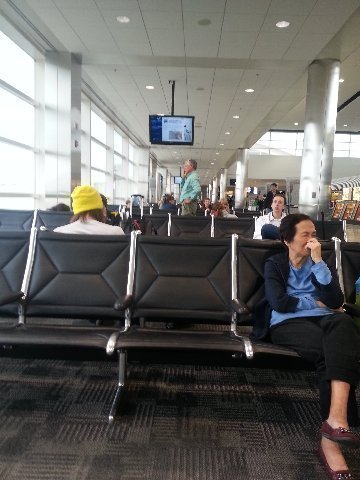
Above: Airport shot, Detroit, Michigan. 11 March 2013.
I have now visited all 50 states... Michigan was the last of the states that I had not visited.
But, have I really been in Michigan? Even today?
Can I say I've been to Easter Island, when the Lan Chile Airways airliner in which we were flying only touched down at Easter Island for an hour of transit time on a flight between Auckland, NZ and Santiago, Chile in 1976? We were able to exit the aircraft, and there was, set in front of the airport lounge, one of those ancient stone icon statues they had brought in from the beach.
Prior to 2010 when I really did go to Alaska to ride a motorcycle from Anchorage to Deadhorse and back, could I really say that I had been to Alaska by just spending the night at Hyder, Alaska on a motorcycle ride through British Columbia? Hyder is the point the furthest south in Alaska and is only reachable from Canada or by sea. There is no access to Hyder by land from any other point in Alaska.
So, does a transit in Detroit on a flight between Salt Lake City and Miami qualify me as being able to say I've been in Michigan.
Such are the existential questions pre-occupying the mind of an aging, deteriorating geezer.
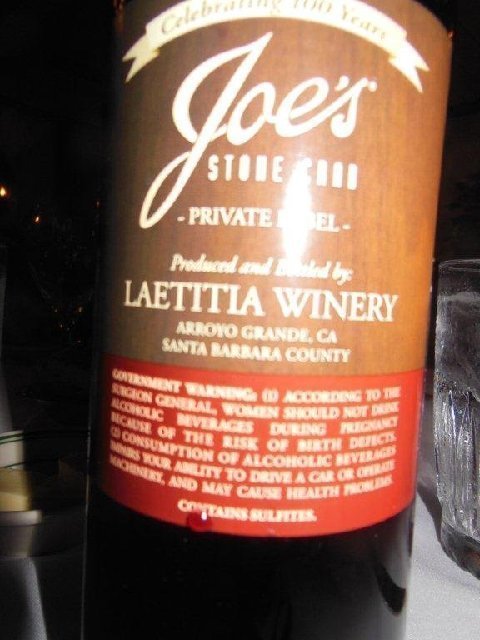
Above: House Cab at Joe's Stone Crab in Miami Beach, FL. 11 March 2013.
How could I turn down an invitation to Joe's from Mezzanine and Magnolia?
The last time I had gone to Joe's was about 8 years ago, to a private equity limited partner dinner, also hosted by Mezzanine.
I had gone to Joe's, usually for lunch, two or three times a year between 1991 and 1995. Then, I was also a guest... a guest of Shepard Broad. Shepard was the founder of American Savings of Florida, a three billion dollar thrift with thirty or so branches astutely located in or adjacent to burgeoning retirement communities in south Florida.
Shepard's bank started to get into financial difficulty in the early 80's (it had become publicly traded by then) along with most other US Savings and Loans, when rising interest rates introduced by the Federal Reserve to stymie inflation put a squeeze on thrifts whose long term mortgage assets were mostly fixed for long durations, but, whose deposits, which were required to fund the loans, were shorter term. When the deposits matured, new deposits would have to pay higher rates. Because the mortgage rates were fixed, the rising deposit rates squeezed out all the profits.
Too late thrifts were allowed by regulators to introduce adjustable rate mortgages where rates could rise and fall along with short term interest rates. This alleviated some of the problems... but, for some banks, adding adjustable rate mortgages to their portfolios was not enough. Many banks, including American Savings of Florida, tried to resolve their profit problems by taking on risky commercial real estate loans.
Not only did American Savings exacerbate its profit squeeze with commercial real estate loan losses, Shepard also invited new investors into the bank to replenish the diminished capital affected by the losses. The new investors, also invited to participate in management, were bad actors and engaged in fraudulent activity.
By the late '80's Shepard, and regulators, were able to oust the bad actors and seek additional replacement capital. But, Shepard had had enough. He sold out his remaining, controlling, tainted share of the bank to a Drexel, junk bond funded, entity that further, via more mismanagement and shady dealings, brought the bank to the edge of insolvency.
In 1990, Mezzanine, a recently retired Goldman Sachs partner, joined an Alabama group appointed by the trustee of the now bankrupt Drexel funded entity that now owned half the ASF stock, to go on the board of American Savings, help rescue the ailing bank and provide some proceeds to the bankruptcy estate of the failed parent.
Mezz headed the search committee of the new board, which hired me as CEO of ASF in 1991, to lead the clean-up and turn around. With a lot of help from a good management team, an active board, and cooperative regulators, we succeeded in the turn around task and sold the bank, in 1995, to First Union Corporation for around $120 million. When I arrived in 1991, the stock was valued at less than five million dollars.
Mezz and I (and our wives) have remained friends over the years. Mezz and Magnolia have a ski place in Park City and Mwah (sic) has participated in investments teed up by Mezz.
Dining with Mezz and Magnolia this evening kind of closed a loop.
Though Shepard was out of the bank, he was interested in its progress. Through my tenure there, 1991 to 1995, Shepard, now over 80 years old, would dine regularly at Joe's. At that time, Shepard was the only person I was aware of who could walk up to the maitre d' at Joe's and be given a table, fast... no questions asked... sans reservation.
There was a lot of "inside" stuff I couldn't relay to Shepard, but, I was able to give him a sense, generally, of the progress we were making to restore the "good name" of his bank. I know he seriously regretted the decline of American Savings and how, some bad actor investors were invited in, on his watch, when the bank profits were being squeezed. He was very interested that the bank's reputation be restored.
It was.
How was the loop closed?
Mezz and Magnolia pick me up this evening at the Beacon Hotel on South Beach and we make the short drive to Joe's. The place is packed. The bar is full. People, waiting for tables, are sulking in the lobby. Mezz and Magnolia, me trailing behind walk right up to the Maitre d', who looks up, smiles, drops what he was doing, and says, "Mezz, good to see you again. How many? Three? Right this way!"
From Shep to Mezz...the loop is closed. At Joe's Stone Crab, Miami Beach, FL
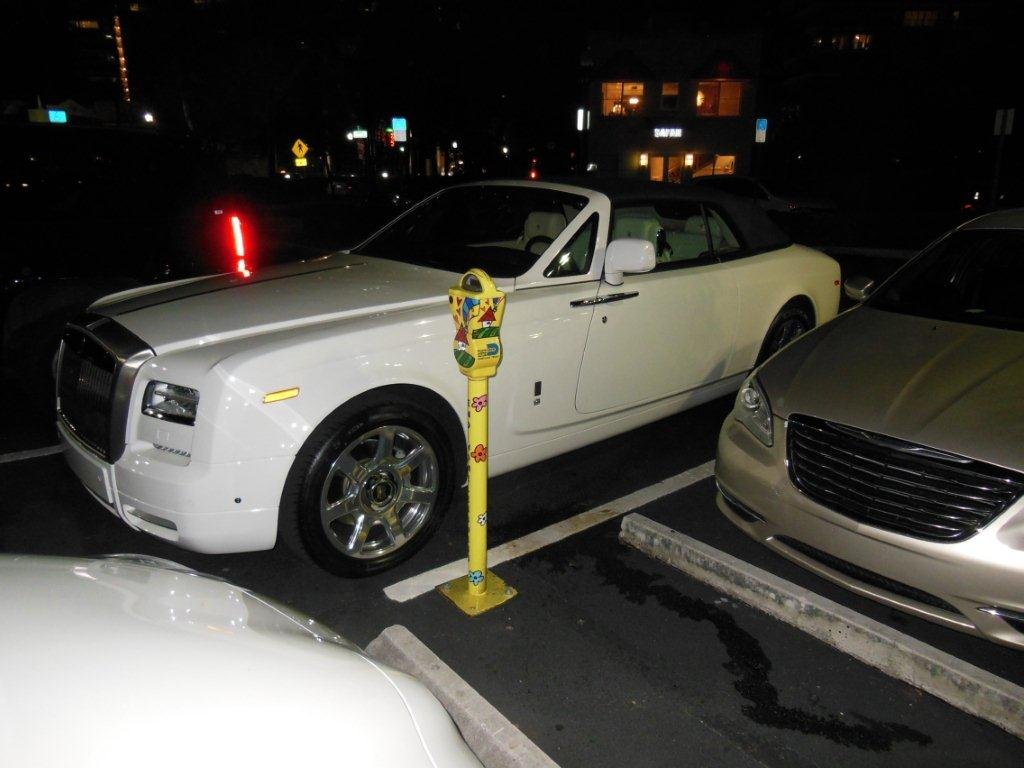
Above: Rolls convertible in Joe's Stone Crab parking lot. 11 March 2013.
Miami is a town of conspicuous consumption. Rolls? zzzzzzzzzzzzzzzzz. How about a Lamborgini?
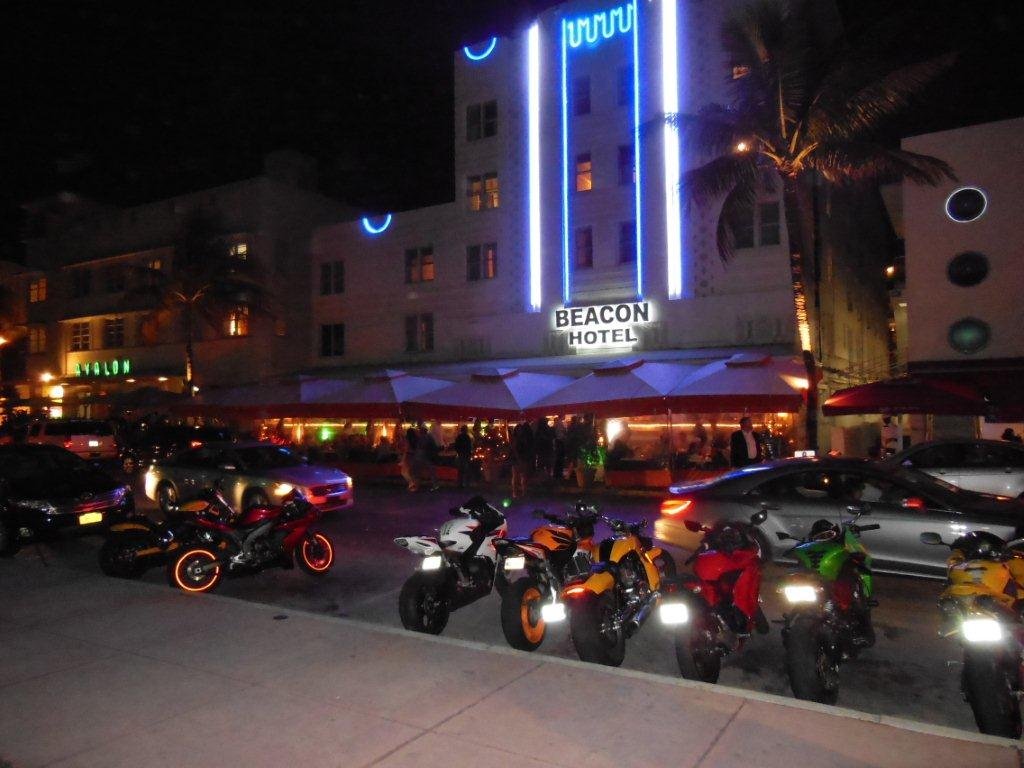
Above: My hotel on South Beach, Ocean Drive. Beacon Hotel. 11 March 2013.
I'll meet my Cuba motorcycle tour mates at this hotel tomorrow. They'll enjoy looking at all the hot motorcycles in the area.
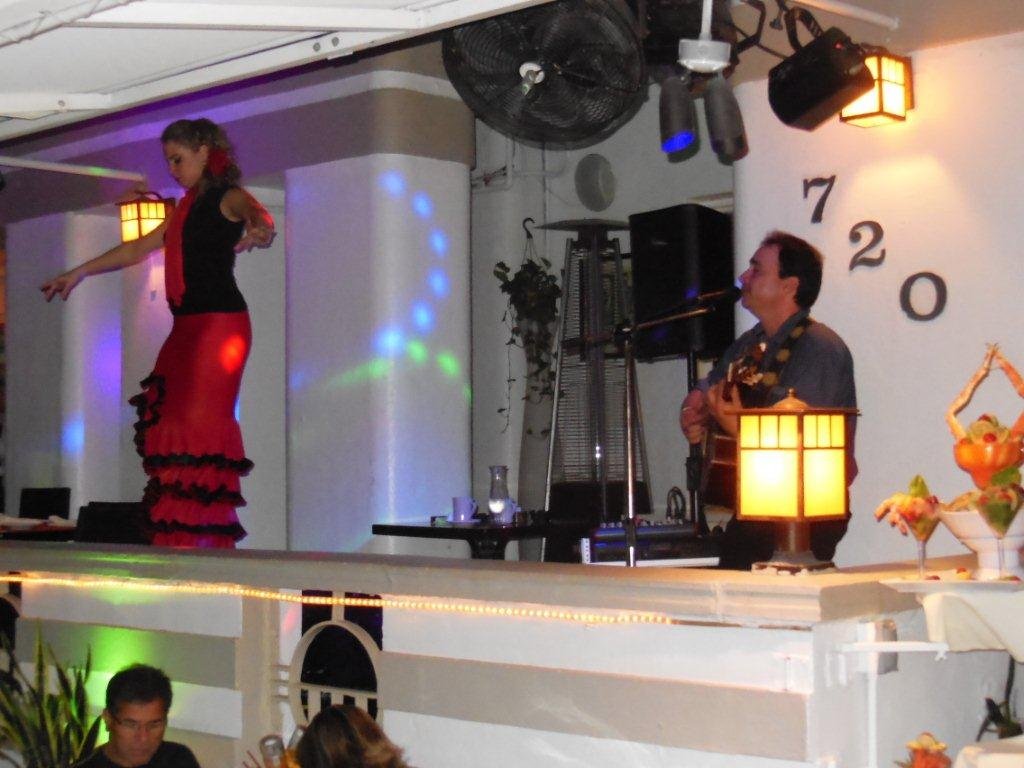
Above: Nouveau Flamenco. Dining outside at the Beacon Hotel. 11 March 2013.
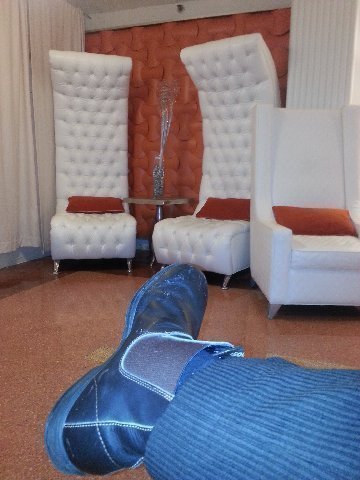
Above: Art Deco. Beacon Hotel lounge. 11 March 2013.
Addendum:
If you are still at the airport (Detroit) try a Coney Island Hot Dog; it may well be the only good thing left!
Contador,
Devon, UK
So sorry to hear that you are going to Cuba as each dollar helps a government that is a dictatorship without the freedoms that we as Americans believe in. My uncle was executed in Cuba in 1962 along with many others since. Daily, men and women of the opposition are jailed for just wanting to meet or attend public events. I hope you get to speak to dissidents in the Island. This is the story of the plight of a population without freedom, but no one listens in the world or cares for that matter.
Best regards,
Lianne,
Miami, FL
Our tour is part of a cultural exchange authorized by the US Treasury department. As a precondition of our tour we are to have interactions with people of Cuba and to document these interactions. Likely the US authorities who authorize these tours see benefit coming from having Americans exposed to individual Cubans "on the street." (and vice versa).
Same here...snowed an inch an hour yesterday and still found untracked as late as 2pm. Total bluebird today and best of all had the grandkids on the hill with us.
--
Mickey,
Aspen, CO
Agreed but what you missed in Detroit was the future of America if we stay on the track we are on. AB
“I admit to having a hard time today. The powder snow was heavy... wet. For me, more concentrated effort had to be put into each turn. Add fog... flat light... and after the snow was cut up a bit, it was easy to get spooked.”
I’m glad to hear that that someone else found the fresh snow like skiing through a Slurpee. Deanie and I struggled with making our turns and the flat light made it tough too. We’re hoping for groomed slopes on Monday when we go again. Maybe we’ll run into you at Deer Valley.
Captain Kirk, Park City, UT
Spectacular photo! I stood at the top of Timp once - age 14 and with your Mom and Dad and Uncle Richard. We started out at 4 a.m. and got to the top mid-day and then slid down the glacier on a gunny sack - I got up too soon and tumbled 15 - 20 feet and also got frost bitten toes!! I can't remember the type shoes I was wearing but I do remember thin cotton sox that I wore and we rubbed my toes to get them circulating - they were pretty numb.
memories!
jdt

Above: Phin and Xan at PCMR 10 March 2013. Image by FeeBee.

Above: TIMDT holding Caleb... Zach in the foreground. At our home, 10 March 2013.

Above: Zach getting licked by K2

Above: Magnolia and TIMDT in India last week.
12 March 2013 - First Impressions Cuba
I spent the day in Miami. In the AM I took a taxi from South Beach to Coconut Grove where I had breakfast at my traditional breakfast haunt in the late nineties and early naughts - Green Street. I didn't see anyone I knew. I eschewed the usual blueberry pancakes for a veggie omelette and a side of tomatoes.
From Green Street I taxied out to the AAA office near Kendall drive and US one where I replaced my international drivers license that I had either forgotten to bring with me or lost somewhere en route.
I taxied back to Coral Gables where I met with financial advisors at Coral Gables Trust (CGT). TIMDT and Mwah (sic) had recently opened up an account there. The business was started by Mezzanine and some partners ten or so years ago. Mezz is Chairman and CEO. Linda, who was CFO at American Savings of Florida (ASF) when I was CEO there, is COO at CGT. I hadn't seen her since ASF was sold in 1995 and I enjoyed a brief reunion with her today at CGT.
From CGT I taxied back to South Beach where, before returning to The Beacon Hotel, I stopped to fill a prescription at Walgreens on Collins and 5th.
Later in the afternoon I met up with my trip mates and joined them for a late lunch at a deli on South Beach.
In the evening we were gathered in the Art Deco lobby of The Beacon by MotoDiscovery trip organizer, Skip Moscorro, where we received a briefing on the upcoming trip. We are going to Cuba, legally, under an Office of Foreign Asset Control (US Treasury Department) authorization which requires us to engage in people to people interaction and make notes of our experience.
We dined at The Pelican restaurant on South Beach before turning in for the evening.

Above: Waiting for bags to come off the luggage turn table at Havana airport. 13 March 2013.
We flew from Miami to Havana on a Boeing 737-400 aircraft chartered by SkyKing airways. The plane was full of passengers, most of whom were Americans of Cuban descent, who, under OFAC authorization were visiting relatives in Cuba.
The check-in at Miami airport and the baggage delivery at Havana airport were both somewhat chaotic as the Cuban Americans visiting Cuba brought disproportionate amounts of luggage... which included electronics, toys and gifts for the Cuban resident relatives While the check in - we left the hotel at 5:30 AM and baggage delivery - we didn't get the bags until about noon - were long and tedious - the plane was only airborne for about 30 minutes - the process worked well... no bags from our group were lost or misplaced, which for a time seemed to be a distinct possibility considering the seeming chaos of a couple of hundred passengers scrambling for luggage.

Above: Vintage US autos in Havana airport parking lot. 13 March 2013.
It is almost common knowledge that Cubans have kept US cars from the 1940's and 1950's - pre revolution (1958) - in working order, for me the scope of the phenomenon was larger than I had imagined. On the trip from the airport to our hotel, the Avenida Quinta Hotel in western Havana's Mirimar district, I'd guess that one out of four vehicles on the road was a vintage American car.
David Madeira, eat your heart out. America's car museum is really in Cuba. You do a double take when a shiny purple 1968 Olds convertible cruises past. I saw a couple of 55 Chevys ( owned one when in high school in the early 60's ... it seemed old tome then!) on the road in from the airport to the hotel.
Isetta told me that most of the cars do not have original engines. Cuba imported thousands of diesel engines in the early 90's and provide economic incentive for car owners to convert to the new engines, promising availability of parts and service, which could not be delivered for the aging US engines. It sounds funny to hear a 59 Buick with a diesel note pass by.

Above; Son Pour Quatro band at El Ajibe restaurant in Mirimar, Havana, Cuba. 13 March 2013.
If the first impression of Cuba was the vintage American automobiles, the second, for me, surely was the music. This small group produced toe tapping, syncopated, Latin rhythms that made me want to extend the lunch hour and get up and wiggle a bit.
Think, "Guantanamera" for a generic sense of the music.
El Ajibe restaurant, is a government owned restaurant. It was our first stop after leaving the airport. The restaurant was full of foreign tourists.

Above: Fare at El Ajibe. 13 March 2013.
Beans, rice, chicken, and french fries.
Having eaten only a banana at 5:30 AM in Miami, I was ready for this meal.

Above: Che Geuvara's image and Cuban flag on government building in Liberation square, Havana, Cuba. 13 March 2013.
Che is a hero of the 1958 revolution (if you're on the side of the 1958 revolutionaries.

Above: Cathedral Jesus de Mirimar. 13 March 2013.
Image shot from 5th floor window of our hotel, Avenida Quinta Mirimar.
Cars.... music.... food.... communism in Cuba.... religion Cuba.... all topics, introduced above, that I hope to develop more insight on as the trip progresses. And not the only topics: a central purpose of our trip is to have a cultural exchange.... I look forward to meeting individual Cubans in this regard.

Above: Downtown Havana, looking east from Hotel Avenida Quinta Habana. 13 March 2013.
Havana is a large city. Over 2 million population. There are broad, tree lined, well landscaped avenues, not much traffic.
Cuba remains a Lenin/Marx communist country and is under a long standing economic embargo by the United States and its allies.
There is little or no advertising apparent (so far). Seeing Havana reminds a bit of my two visits to the Soviet Union, one in the 60's and the other in the 80's, where limited traffic, exotic autos (Ladas), and limited apparent retail activity also prevailed. When the government owns almost everything, there seems to be little need to embellish anything. Some might say that is a good thing... waste not want not... but, others would say that people would be more creative and lively if they had a little more freedom. More thoughts later.
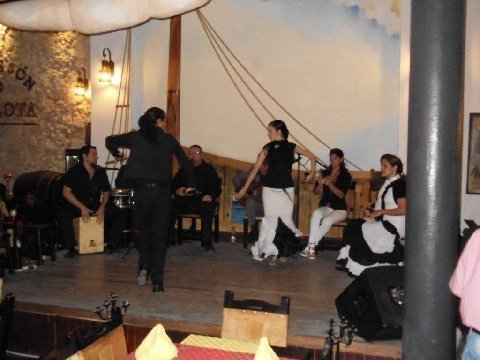
Above: Flamenco at evening restaurant, Maison de Flota, Havana historic district. 13 March 2013.
More terrific music!
I was reminded of a Flamenco experience I had in Madrid about four years ago, attending one of the top Madrid Flamenco performances while nursing Marie Brizzard anises.
The dance is intense and emotive. The quality of the dancers and the musicians was excellent.
Addendum:
Deanie and I stayed at that same hotel on South Beach several years ago during Spring Break. The constant procession of cars cruising the boulevard out front of the hotel reminded me of the kids cruising State Street in its heyday. I hope you have a safe and enjoyable trip to Cuba.
Captain Kirk, Park City, UT
Steve, thank you for your kind words in blog. We really enjoyed catching up with you and hope your trip to Cuba is safe and interesting. Looking forward to hearing all about it over Shooting Star chili in a couple of weeks.....
I met with Chuckie Schumer in a small luncheon meeting today arranged by SBA and will send you my comments.
Safe travels!!!
Mezz,
Miami, FL
Nice furniture in your room - CRAZY but cool!
You are still my idol!
David,
Salt Lake City, Ut
PS - cool days in the late 70's - IMSA Porsche racing under the banner of GERRARD "Record Players"! I remember this car but still amusing to imagine them as a sponsor. ROCK ON!
I am sitting in the Detroit airport right now.
fish,
Detroit Airport
Can you say that you have been to Michigan because you were in the detroit airport? Can I say that I've been to Australia because, due to lack of a visa, I was imprisoned in the Sydney airport for 12 hours on my way To New Zealand? The answer to each is "NO". Have fun in Cuba.
The Zookeeper
Williamstown, MA
You were in Michigan--if only for a plane change! You wouldn't want to see Detroit--up state would be nice.
the monk,
salina, ut
Steve I grew up in Michigan and you really need to do a bike trip around the Great Lakes and interior in the summer, it is a beautiful state.
JCBuilder, Park City, UT
And what is "K2 in the foreground" -- chopped liver??
Tevye, Mahwah, NJ
14 March 2013 - Havana by Motorcycle
Today we motorcycled out to American novelist, Ernest Hemingway's home in the southern outskirts of Havana. We rode to the small bay where Hemingway kept his boat and where he was inspired to write "the Old Man and the Sea." We rode to the Morro Castle, at the entrance to Havana Bay, where we had lunch at a nearby restaurant. We then took a short ride to historic, downtown Havana where we walked the old, cobble stoned streets, listened to more music, and for those interested, "souvenired (sic) up." We dined that evening at a private restaurant in a pre-revolution home in central Havana. We rode about fifty miles during the day.
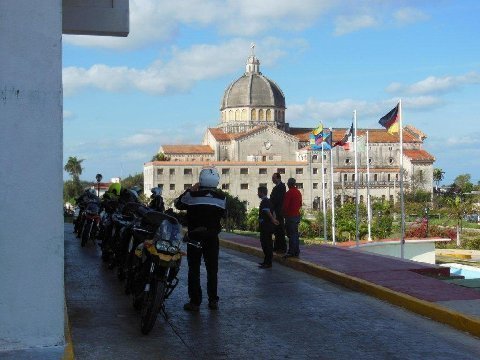
Above: Preparing to ride at our hotel, Quinto Avenida Habana Hotel. Cathedral Jesus Havana in the back ground. 14 March 2013.
Hotel Quinto Avenida Habana Hotel is four miles from down town. We are booked to stay in a down town hotel on our return to Havana in a week's time. According to tour leader Juan Stanglmaier, bookings are very difficult to get in Havana. The number of tourists here stretch a creaky tourist infrastructure to the breaking point.
While beginning the ride into the city of Havana, Cuba, the international cities where I had motorcycled start streaming through my mind: Istanbul, Antalia, Bodrum, Darjeeling, Niigata, Axum, Livingstone, Palermo, Addis Abbaba, Johannesburg, Dar es Salaam, Quito, Milan, Nice, Orsono, Naples, Saigon, Hanoi, Tokyo, Paris, Lusaka, Tiujana, Francistown, Guymas, Cuenca, Thimphu, San Juan de Bariloche, Guwahati, Marakkesh, Ulan Bator, Lima, Punta Arenas, Ushuaia, Genoa, and more that don't immediately come to mind.
Fantasizing just a bit, the motorcycle for me has been like an explorer's ship... say, the Nina, the Pinta, or the Santa Maria, which was captained by Columbus on his own voyage to Cuba in October of 1492. The motorcycle is the "vessel" that takes me, channeling Columbus, to exotic locations... to explore heretofore unseen worlds. Mixing metaphors: "these are the voyages of the starship Enterprise!" (Cough).
OK. I'm not Columbus... or Picard.
My exploration has been ordered...set up... planned by experts who have covered the ground before me: The Cuiba trip has been organized by MotoDiscovery Motorcycle Tours run by Skip and Nancy Moscorro, San Antonio, TX, http://www.motodiscovery.com/
The Moscorros provide me with a good motorcycle, a tour manager (Juan Stanglmaier), a luggage van, a good motorcycle riding, local guide, (Luis Enrique Gonzales Saez)... admittedly, a bit cushy compared to the solitary, world motorcycle adventuring of Dr. G. Yet, exploring the world on a motorcycle, notwithstanding the planning and backup that goes with it, provides just an element of the same adrenalin rush that Magellan might have felt, say, on cruising through eponymous straits on the back side of the world centuries ago.
Though the trip is well organized for us, the riding of the motorcycle is not a perfunctory or passive activity. Riding requires a heightened level of alertness, top reflexes, and considerable physical stamina. It follows that motorcycle riding, because of these mental and physical demands, leads to heightened and enhanced awareness of place. The riding and the place are mutually supportive.
The thought of Cuba by motorcycle brings forth a disjointed, stream of conscious, set of images: The Tropicana,. Mayer Lanski, Desi Arnaz, Hemingway, sugar cane, conquistadors, pirates, Santeriea, The Bay of Pigs, "the Cuban missile crisis," Fidel Castro, cigars, "The Miane," The Spanish American War, San Juan Hill, Che, "The Godfather," old American autos, musica,"Scarface," doctors, military interventionism (Africa) and la revolucion.
In addition to having a good motorcycle riding experience, while in Cuba for the next week, I hope to add some texture to the aforementioned, images of Cuba now racing through my mind.
Americans (there are two Brazilians and one Brit in our group.. our tour director is Mexican and our ride leader is Cuban) are not supposed to travel to Cuba. The US travel ban to Cuba is part of a US embargo placed on Cuba in 1960, almost two years after the 1959 communist revolution brought Fidel Castro to power and saw dictator strong man, Fulgencio Batista sent into exile. The American embargo was a response to Cuba's nationalization of $10 billion (current dollars) of American assets with no compensation provided in return.
In later years, the United States added Cuba's putatively poor record on human rights as a reason for the embargo.
The Human Rights Watch alleges the Cuban government "represses nearly all forms of political dissent" and that "Cubans are systematically denied basic rights to free expression, association, assembly, privacy, movement, and due process of law."
After China, Cuba had the second-highest number of imprisoned journalists of any nation in 2008.
Cuban dissidents face arrest and imprisonment. In the 1990s, Human Rights Watch reported that Cuba's extensive prison system, one of the largest in Latin America, consists of some 40 maximum-security prisons, 30 minimum-security prisons, and over 200 work camps.
Over the last ten years, Cuba has slowly... gradually... lifted some restrictions on its citizens. Under some circumstances, Cubans are able to travel abroad or start their own businesses. A small entrepreneurial class has taken hold. The country has opened - albeit on a limited, strained basis - itself to foreign tourism.
Some foreign tour agencies and hotel companies have entered into joint ventures with the Cuban government.
Because of the embargo, little perceived progress of Cuba addressing its poor human rights record, and no progress in Cuba redressing the "taking" of billions of dollars of American assets, America has resisted supporting Cuba's tentative steps to open its country to foreign tourists.
Except.
The US Treasury Department's, Office of Foreign Asset Control (OFAC) has authorized exceptions allowing Americans to travel to Cuba. Journalists, Americans with relatives in Cuba, educational groups, and special interest groups pursuing a "people to people" exchange (there are rules on what "people to people" entails) may all apply for OFAC approval to travel to Cuba. As far as the "people to people" visits are concerned, apparently the US government believes that a citizen to citizen interchange between Cubans and Americans does not violate the purpose of the embargo... after all (or so the logic goes) let the governments sort out their problems... that shouldn't prevent people to people contact. Just sayin'.
MotoDiscovery has applied for, and received a "people to people" permission for authorized Cuba travel... and, it is under the auspices of that permission that I and my rider friends travel to Cuba today. We are legal US travelers to Cuba
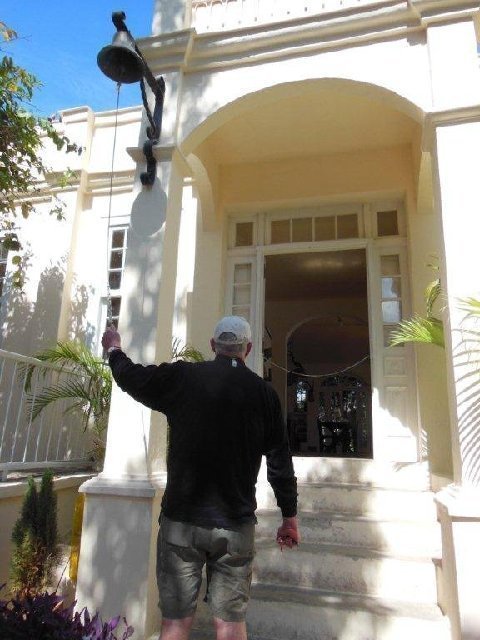
Above: Tourist "tolls the bell" (get it?) at Hemingway's Havana house. 14 March 2013.
Hemingway's Havana home has been well preserved by the Cuban tourist bureau.
Hemingway never renounced the communist revolution of 58... in fact he praised the revolution as a good thing.

Ernest Hemingway and Fidel Castro after a fishing contest in Cuba in 1960.
Miffed US authorities told Hemingway that he must take back his pro revolution stance, or leave the country. Responding to US government pressure, he left his home in 1960 and went to Ketcham, ID.
Hemingway took his life in Ketcham in 1962.
The care taken by the Cuban tourist people to preserve the Hemingway estate was impressive. The responsible tourist bureau representative, Anna Rosa Alfonso....., smiling brightly, and enthusiastic in her speaking style, welcomed our group (in Spanish translated by our tour leader Juan Stangmaier) to the beautiful estate, located, with a spectacular view of Havana, in the hills south of the city.
After receiving a guided tour of the estate... "here's the guest room where Clark Gable stayed...." Anna joined up with us again. She made a passionate statement articulating the evils of the US embargo on Cuba. School children were deprived of learning materials. Schools could not afford field trips to the Hemingway property to learn of Papa's contribution to literature... and so on.
No doubt the upkeep of the Hemingway property by Cuban authorities is influenced by Hemingway's praise of Castro and political stance on the benefits of the 1958 Communist revolution.
From the Hemingway house, our group rode the motorcycles to the small bay where Hemingway kept his boat and the place which inspired his novel, "Old Man and the Sea."
There, Narida Nunez, a woman of a certain age, playing the "rattles," and backed up by her husband on the guitar, serenaded us with some syncopated Cuban melodies.
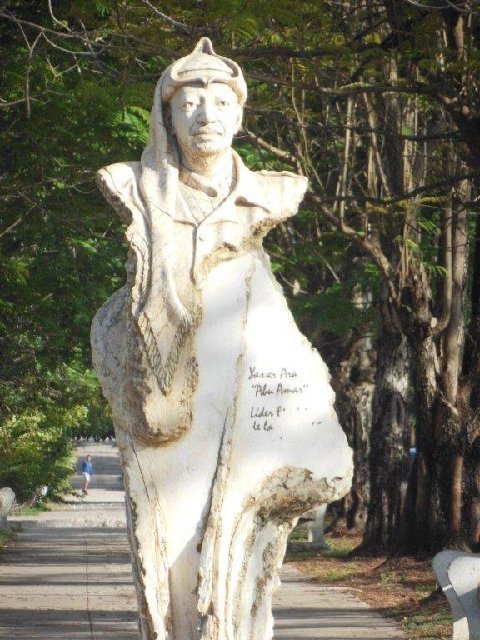
Above: Statue of Yassir Arafat on a Havana boulevard. 14 March 2013.
Cuba and the Palestine Liberation Authority are joined in solidarity as members of the non-aligned nations group.
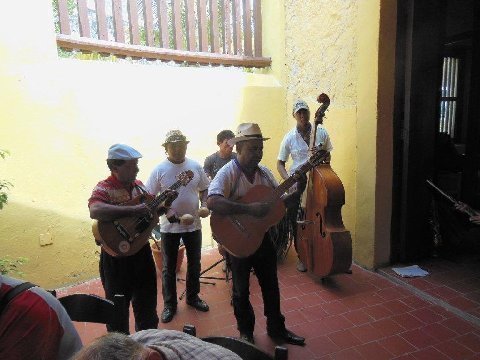
Above: Andy Aldana de Santiago and his band play at lunch at Los Doce Apostles restaurant near Morro Castle in Havana. 14 March 2013.
Listening to Andy's band at a nearby table, I was mesmerized by the cowbell lying at the foot of the percussionist.
Finally, I couldn't take it any more. I walked up to the band, picked up the cowbell and the mallet, and struck to the syncopated salsa beat. The band guys beamed seeing me participate.
The percussionist pointed to the rasp gourd... "play that," he motioned with his head. So, I switched instruments. Desi Arnaz, eat your heart out.
Minutes later my riding friends, the tour guides, and even some of the restaurant employees were dancing or standing swaying to the rhythm of the beat. The sedate lunch patio had turned into a dance floor.
You want "people to people?" This Cuban American jam session was a good start.
For, me the ubiquitous music has been a true highlight of the trip so far.
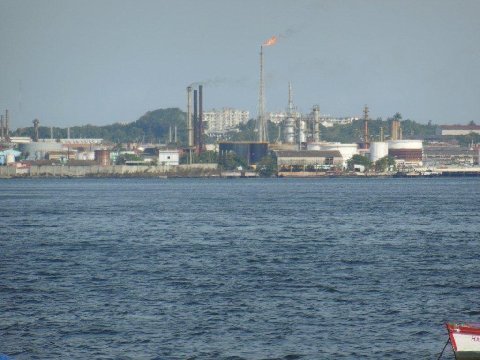
Above: Havana oil refinery, Havana Bay. 14 March 2013.
Cuba imports oil from Venezuela, refines it, and ships much of the gasoline back to Venezuela as a source of government revenue. Cuba also sent several thousand doctors to Venezuela as compensation for oil imports.
There is some apprehension in Cuba today (so I'm informed by people who spend time in Havana) about the relationship between Cuba and Venezuela considering the recent death of Castro's pal, Hugo Chavez. Will the monetary subsidization first received from the Soviets, and currently received from Venezuela continue?
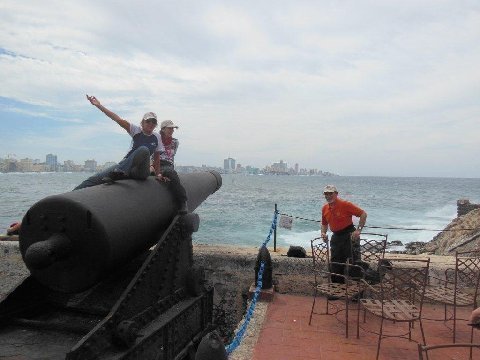
Above: Sonya and Claudia, the two Brazilian members of our riding group, sit on antique canon at Morro Castle, Havana. 14 March 2013.
Isetta, our spiritual leader, stands at right. Havana's famous Malecon sea side sea wall and walkway is seen in the far distance.
The Spanish set foot in Cuba in the 16th century. Havana Bay, protected by the Moro fortress, in the day, provided commercial shipping with a safe haven from pirates.
Sonya is a divorcee, mother, and business woman who runs a farm, a real estate business, and a gas station.
Claudia, a widow, and grandmother, runs her family's real estate business. Her daughter and husband, for seven years ran a chain of retail stores in Angola. They are now back in Brazil attempting to get a start at retailing. Another daughter is studying culinary arts in Los Angeles.
Both women ride BMW motorcycles in Brazil.
Isetta is a real vector changer in my life having been the organizing instrument for many of my motorcycle trips around the world.
Isetta is an antique motorcycle and small car collector.
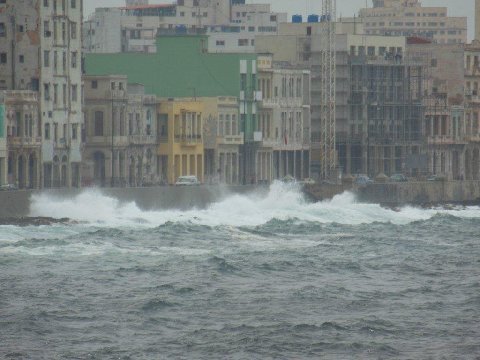
Above: Waves crash against the Malecon, the wide walk way that brings tout Havana to promenade, see, and be seen. The Malecon is to Havana what the Eiffel Tower is to Paris, or the opera house to Sydney. 14 March 2013.
The Malecon stretches four miles from Marina Hemingway in the south, to the Historic District near Havana Bay.
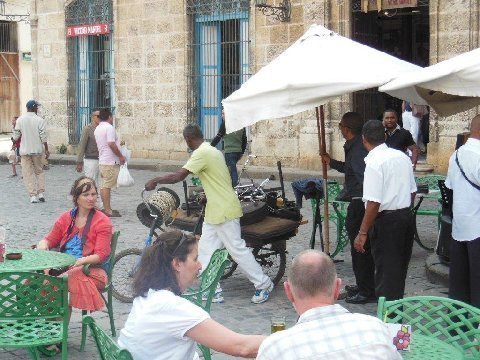
Above: Plaza des Armes, historic downtown Havana. 14 March 2013.
I sat at this table to watch another band: Chocolate Caliente.
In the image, one disbanding band member carts away the stage piano and other instruments on a bicycle rig.
Cuba's economic performance since the 1959 revolution has been poor. This requires Cubans to be very resourceful to survive... in this case, the band has no van... but they move their stuff on a home made bicycle contraption notwithstanding. It would seem that this type resourcefulness, seen also in those who keep the old cars running, would stand Cubans in good stead to succeed in larger economic ventures if private business ownership were restored. 80% of Cuba's GDP comes government owned enterprise.
The music everywhere is wonderful. And, it is music. Its about the music... not some contrived show performance with fireworks and lights we see so much of in America today... American music is going downhill ie. American music is so bad that it has to be supplemented with glitz to get unwitting young people who know no better to tune in.
No one will be singing Beyonce or Taylor Swift in fifty years.
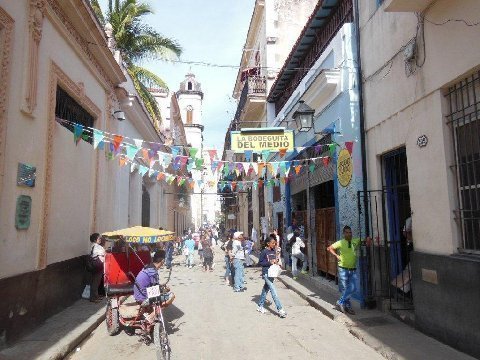
Above: La Bodeguida del Medeo bar. One of Hemingway's favorite bars. In the historic district of Havana. 14 March 2013.
I stopped by this bar to hear some music. The flute plays a big role in Cuban salsa music... and, there was a terrific flutist playing in this bar.
I now understand the musical provenance of Cuban origin, Miami jazz flutist, Nestor Torres. It (salsa jazz flute) started here in Havana. Many of the Cuban salsa bands have a flute player.
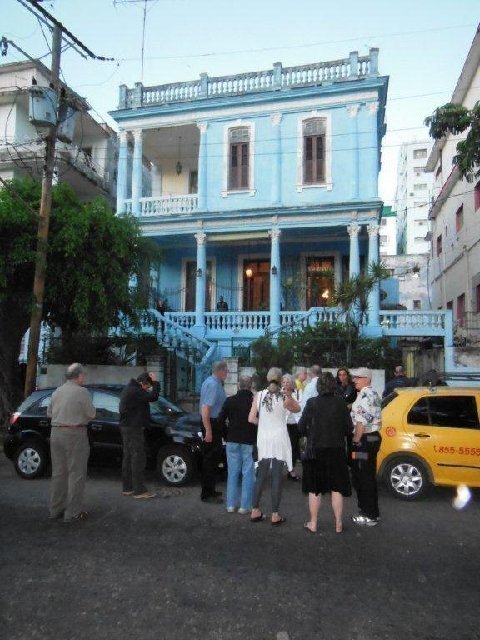
Above: La Chansonnier restaurant. Our dinner place. We left the bikes at our hotel and took a van to the restaurant. 14 March 2013.
The Cuban government has relaxed restrictions on private ownership. This restaurant, in a re done old Havana home, is privately owned. The cuisine was French... fine dining. Who knew?
Menu items for the evening were three: Chicken bits in orange sauce reduction. Lobster tail - baked. Roast duck.
Our tour leader, Juan, a Mexican national, told us that the lobster were found in Havana harbor. Until recently, he noted, there had been a restriction on farming the lobster... now lifted for private restaurant owners.
Members of our group are in the foreground.
Addendum:
Terrific report. .gracias!
el Contador
Devon, UK
Steve,
A number of people we know over have visited Cuba although, interestingly, not under the guise by which you are traveling! The reports back were all the same: lovely people, great music, interesting place to visit - once - but just like going back in time!
I do hope that you will really get to meet "los cubanos verdaderos" on your travels and that it will not be too stage-managed.
Buen viaje, amigo!
Eton Mum
Devon, England
thanks steve .great insights and inside look. (you gotta question anybody who savors those american relics as drivers. at least in argentina they keep them inside glass.)
Brand Man,
Venice, CA
Just returned from Ketchum/Sun Valley where the Hemingway story was once again brought to mind. During the 80s and early 90s I saw Margaux Hemingway often on the Delta Flight from JFK to SLC. The first time I saw her enter the cabin I recognized her but was struck by how tall she was. A few times we shared seats in the first class. She was a very interesting woman and I regret the demons that plagued her to take her life.
Try to speak with some people that are not programed for your visit. Try the street vendors if there are any or folks on the beach. Folks will be reluctant to speak honestly with you if they know they are being watched. Have a great trip and tell all when you return.
The Monk,
Salina, UT
Steve:
I pass Laetitia Winery frequently driving to and from SoCal. How is it?
The Bohemian,
San Francisco, CA
not bad!
The only other Joe's Stone Crab restaurant used to be in Tokyo where fresh stone crabs were flown in daily. Did you get a chance to eat there when you were managing CCKK in the 1980s? I wonder if it is still in business.
Nathans,
Orlando, FL
I think there's one in Vegas... at Ceasar's Palace. Never went to the one in Tokyo
I second the motorcycle trip around both the upper and lower parts of Michigan ... Petosky, Boyne, Traverse City ... et al.
Music in the Mountains,
Park City, UT
Somehow the separation between Detroit and Miami seemed intergalactic. Hello captain Kirk, can I beam you up?
Systems,
somewhere on mid fl coast
15 March 2013 - Vinales
Leaving Havana, on our first day of motorcycling outside of the capital, we rode west, 260 kilometers, by freeway and country road to Vinales, in Pinar del Rio provence.... cigar tobacco country, Cuba's furthest western provence. We made stops along the way at Mariel, Las Terrazzas, and Cuevo del Indio before reaching Vinales, and Hotel Los Jazmines, our destination for the evening.
We are riding current model BMW F800 GS and F650 GS motorcycles provided by Xpedit.DK, of Copenhagen, Denmark. I dined seated by Mike, Danish owner of the Cuba BMW motorcycle fleet, on my first night in Havana. I'm riding one of the F800 GS's... the same bike I have at home, a smaller, more nimble version of the R1100 GS I owned for over ten years. Both GS versions ridden here are spirited, fast, and nimble dual sport motorcycles designed for tarmac and gravel roads.
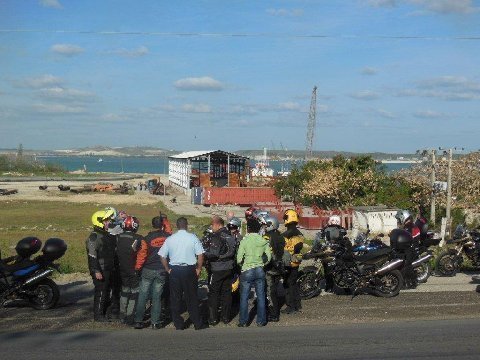
Above: The port of Mariel, 30 miles west of Havana. 15 March 2013.
The image shows the exact location from which the famed Mariel Boat Lift was orchestrated in 1980.
On 06 April 1980, 10,000 Cubans stormed the Peruvian embassy in Havana seeking political asylum. The following day, the Cuban government granted permission for the emigration of Cubans seeking refuge in the Peruvian embassy. On 16 April, five hundred Cubans left the Peruvian Embassy for Costa Rica. On 21 April, many of those supposedly Costa Rica bound Cubans started arriving in Miami via private boats and were halted by the U.S. State Department, but the emigration continued, because Castro allowed anyone who desired to leave the country to do so through this port... Mariel. Over 125,000 Cubans, many of them prisoners deliberately freed by Castro from Cuban jails, emigrated to the U.S. before the flow of vessels ended on 15 June 1980.
Further west from the spot shown in this image, Cuba, with the assistance of the Chinese, is building a deepwater container ship port. This new commercial port is expected to take pressure off the port of Havana, 30 miles to the west, where authorities hope, in Havana Bay, to create a large cruise ship docking operation.
Tourism is a growing source of foreign exchange for Cuba. The tourist infrastructure remains weak and undeveloped, though tourists (mostly European, Canadian etc.) appear to be around in abundance. There are several new hotel starts in Havana... joint venture operations between the Cubans and (mostly) European hotel groups.
To stem the flow of foreign currency circulating in the country (distributed unabashedly by tourists), the Cuban government has adopted a two tier currency system where dollars, euros, Canadian dollars etc. are exchangeable by tourists for Cuban Currency Units (CUCs) which are fixed at about par with the US dollar.
Tourists pay in CUCs (people call them "kooks") while the locals pay in local pesos, valued at about twenty five pesos to the "kook."
Only people in the tourist industry can receive CUCs... one can imagine how eager many Cubans are to participate in tourism. According to one Habenero I talked to, many highly educated doctors, who are paid only a nominal government salary, will give up medicine to become a hotel clerk... where the money is better.
On the other hand, there is not a lot of job security in tourism, where employee turnover is forced by government tourist corporations to ensure that more people get a shot at the tourist revenue and that life doesn't get to secure for those who mayhave otherwise wanted to stay.
Interestingly, when you ask someone... at a souvenir store, a snack bar, or a restaurant the price of something, they reply with a number: "One.... seven.... five or whatever." Not "seven pesos, or seven CUCs," just "seven."
I suspect that no one considered the pejorative meaning of the English pronunciation of the acronym "CUC" before introducing it as a formally accepted means of exchange. Has word has been passed down not to use the pronunciation "kook...?"
So... just don't call it anything at all!
Probably nothing to this. Just an old geezer musing.
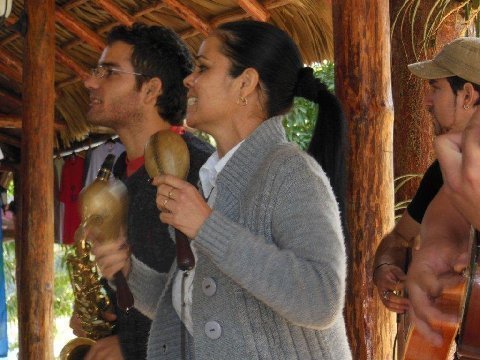
Above: Alabao Band, at Las Terrazzas. 15 March 2013.
We stopped to visit Las Terrazas.
Las Terrazas is a small community and nature reserve in Pinar del Río Province. It is located in the Sierra del Rosario mountain range, which was designated a Biosphere Reserve by UNESCO in 1984.
The village has a population of about 1,000 and a number of hotels and restaurants catering for tourists. The nature reserve includes 5000 hectares of secondary forest which was planted on the surrounding (deforested) hills by building terraces to avoid erosion; hence the name (in Spanish, terrazas means terraces).
The reserve is rich in flora and fauna, and includes lakes, rivers and waterfalls. Organized excursions on the many footpaths and trails can be booked at the local tourist office.
I thought about my motorcycle riding experience in Bhutan three or four years ago, where all forest and log operations had also been suspended.
In some ways, it is sad that logging in poor areas such as Cuba and Bhutan cannot be put on a sustainable footing to improve the standard of living of an impoverished population. Preservation of trees? For whom? Why? Trees can be replanted. Agree... clear cutting without forest planning is dumb... but sustainable logging is not dumb. It is economic growth. This country needs jobs... and forestry is one potential area for development and jobs growth. Tourism in a forested area will have no where near the economic impact of a successful logging operation.
Still, Las Terrazzas was a beautiful spot.
Man in charge, Otis Campa, noted (he was a very capable communicator) that Las Terrazzas is the only sustainable development experience in Cuba. Of note, is the fact that the project produces 32 tons of honey annually (bueno...but, how many tons of honey does it take to make up for the lack of a logging operation?
Otis is also looking at expanding tourist options at Las Terrazzas to include motorcycle dirt biking and mountain bike riding.
Asked about the economics of the project to date, Otis noted that the project was subsidized by the Cuban government.
A good presentation by Otis Campa.... but, I liked Alabao (the band pictured above) best!
Speaking of economic growth, forget about nature reserves. Somehow the Cubans need to better leverage their musicians. The Filipinos have done a great job of turning music into an export. There are few cruise ships or international hotels anymore that don't have a Filipino band playing.
In Cuba... there are bands or groups everywhere... on the streets, in restaurants, hotels. The lively syncopated music is one of the joys being here! It can travel!
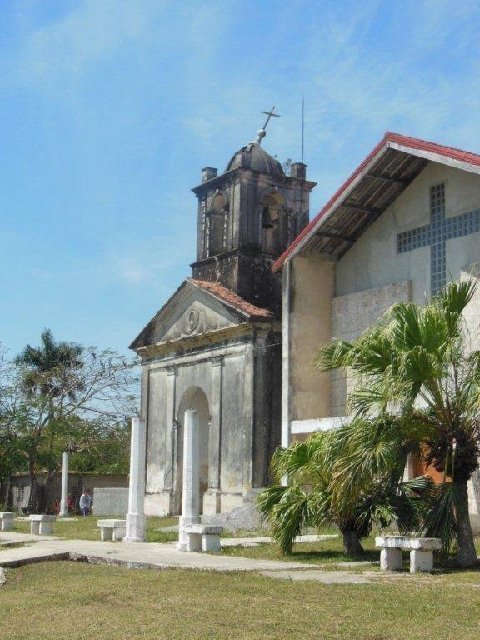
Above: Catholic Church with crooked cross on roof. Seen on road between Las Terrazzas and Vinales. 15 March 2013.
One could come up with all kinds of metaphors for the state of the church in Cuba today, if not the state of organized religion in the western world... by using this image of the crooked cross.
Cuba is officially a secular state. The Castro regime, early on, maintained that churches were fronts for subversive political activity. But, the government reversed course in 1992, amending the constitution to characterize the state as secular instead of atheist.
Roman Catholicism is the dominant faith, with 11 dioceses, 56 orders of nuns, and 24 orders of priests.
Jaime Ortega, the 75 year old Cuban cardinal, was once sent by the Castro government to a military work camp for several months.
Ortega was thrust into the spotlight last year when Pope Benedict visited Cuba.
Considered Cuba’s largest and most influential institution outside the government, the Catholic Church today acts as both a force for reforms and a mediator between the government and opposition groups, including some of the island’s boldest dissidents.
Though the Castro name still rules Cuba, the island's treatment of religion today appears to be a far cry from the days when young clergymen baked under a hot Caribbean sun while toiling in work camps because of their religion.
As I learned while living ten years in Miami, the Cuban version of Catholicism is often practiced in tandem with Santeria, a mixture of Catholicism and other, mainly African, faiths that include a number of cults.
Three hundred thousand Cubans belong to the islands's fifty four Protestant denominations. Cuba has small communities of Jews, Muslims, and members of the Baha'i faith.
Most Jewish Cubans are descendants of Polish and russian Ashkenazi Jews who fled pograms at the beginning of the 20th century. Cuba has a sizable number of Sephardic Jews who trace their origin to Turkey. Most of the Sephardic Jews live in the provinces, although they maintain a synagogue in Havana.
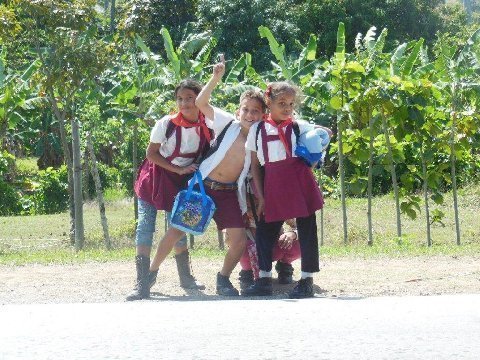
Above: School kids mug for motorcycle riding photographer (Mwah [sic])... seen along the side of the road between Las Terrazzas and Vinales. 15 March 2013.
After the 1958 revolution, Castro created an entirely state-operated system and banned the pre-revolution private schools. School attendance is compulsory from ages six to the end of basic secondary education (normally age 15), and all students, regardless of age or gender, wear school uniforms with the color denoting grade level. Students in the above image look to be in what I would call seventh or eighth grade.
Higher education is provided by universities and polytechnic institutes. The Cuban Ministry of Higher Education operates a scheme of distance education which provides regular afternoon and evening courses in rural areas for agricultural workers.
Education has a strong political and ideological emphasis, and students progressing to higher education are expected to have a commitment to the socialist, secular goals of Cuba.
Cuba boasts a near 100% literacy rate. However, in 1957, just before Castro came to power, the literacy rate was fourth in the region at almost 80%... higher than Spain.
Internet access is limited. The sale of computer equipment is strictly regulated. Internet access is controlled, and e-mail closely monitored by the government.
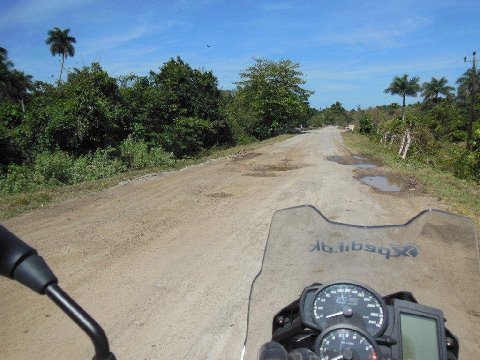
Above: Pot holes were a regular occurrence on the road from Las Terrazzas to Vinales. The roads reminded me of those in Botswana and California. 15 March 2013.
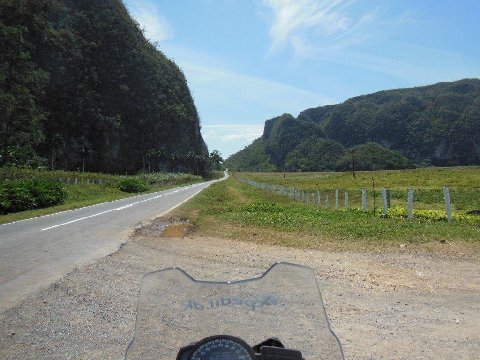
Above: Road scene leading through limestone uplift mountains just outside of our destination, Vinales. 15 March 2013.
Not all of the roads have pot holes. This one is pretty good.
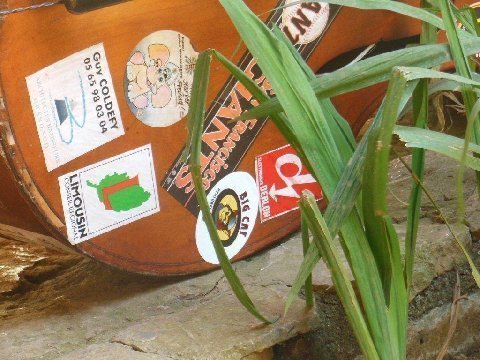
Above: I noted the familiar Big Cat sticker on the bass of the band playing at our lunch stop, Palenque de los Cimarrones, formerly a cave hide out for run-away slaves. 13 March 2013.
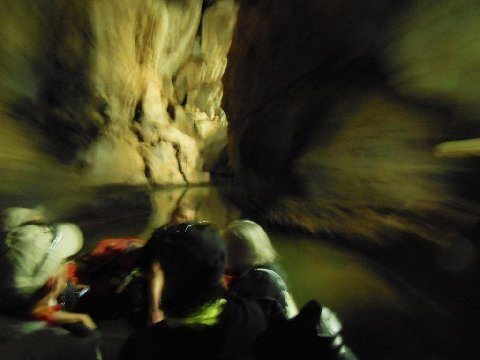
Above: Cueva del Indio (Cave of the Indian). 15 March 2013.
We took a boat ride on an underground river in the cave shown above... just across the street from Palenque de los Cimarrones.
The limestone up-lifts and caves are only 5 kilometers away from the town of Vinales and looking back from our hotel, Los Jasmines, form a beautiful backdrop for the valley.

Above: Drying tobacco for cigars at tobacco farm we visited just before arriving at our Vinales hotel. 15 March 2013.
Most of the tobacco farmers own their own farms. Their only market, however, is to sell to the state which fixes the prices each year. There are good seasons and bad seasons. Cigars have good and bad vintages just like wines. A good vintage tobacco crop will result in a good profit for the farmer... a bad vintage, of course, not so much.
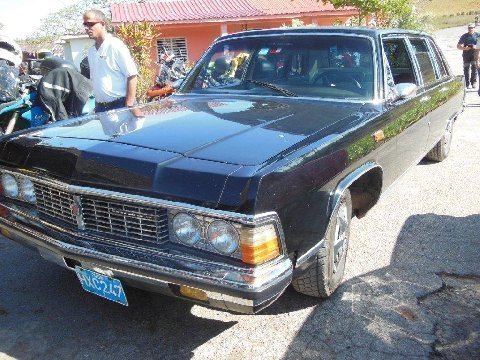
Above: Old Russian Zil stretch limo seen at the tobacco farm. 15 March 2013.
Cuba... a veritable museum of old cars... and not just American cars.
Addendum:
thanks. great reporting--waiting to see the art deco havana:)
Brand Man,
Venice, CA
Hi Steve. Interesting place you are visiting!!
Been in NZ for a couple of weeks - Mum died.
Shaun got into economics faculty of Tokyo University.
I keep telling people he is a real 'chip off the old block' but they all burst out laughing!!!
Maybe they are trying to tell me something?????
Love to all.
Malc,
Tokyo, Japan
Tokyo U. Econ faculty. Rising star! I know that kid! Chip off the old block? Ha Ha.
Merci pour les photos et le superbe et complet résumé Steeve! c'est très apprécié. Je ne sais quand, mais je sais qu'un jour je vais faire transporter ma GSA à Cuba et je vais prendre le temps nécessaire pour explorer cette ile.
Au plaisir de vous relire!
Pete
PS If I recall right, you spoke to me in french at the Big Dog! so, I'm just testing you here! Thank you for the pics and the nice recap. Well done.
*:-h wave
Flic,
Montreal, CA
Merci. J'espere que vous iriez en Cuba un jour. Vous l'aimerais.
Hi Steve
How was your trip To back home ?
Thanks To send me this brillant diary. I am waiting for the all days
Kisses
Sandra
Savi Imoveis - Chamonix
Brazil
Not home yet... stayed overnight in Miami. Fun trip. Enjoyed being with you and the others.
16 March 2013 - Freeway
Today we started early to ride 330 miles, mostly on Cuba's national highway, A1, from Vinales, in Pinar del Rio province, to Santa Clara, in Villa Clara province. The national highway extends over 700 miles from one tip of the island to the other. Villa Clara province (capital, Santa Clara), at the midway point on the island, will mark the furthest east we are to ride in Cuba. From Villa Clara province, Guantanamo province is over 300 miles further to the east.
Much of Cuba, including second city, Santiago, is still left to cover for the next ride!
Santa Clara, in Villa Clara province, is an old sugar town, now better known as the city where, in 1958, Castro's revolutionaries, led by Che Guevara, established in battle, against Cuban strong man Batista's troops, their first major foothold in taking control of Cuba.

Above: Joe and Kathy. 16 March 2013.
Joe and Kathy live in Salt Lake City.
Joe, an Ohio State (OSU) trained engineer, ran his own pipeline construction business, completing projects all over the world.
Joe is a well known motorcycle personality. He is a motorcycle collector, was a winner of national dirt biking competitions as a young man, and has enjoyed a second career in his affiliations with motorcycle racing.
Joe was the field manager for KTM's Dakar racing teams in the mid-2000's, among others.
I first met Joe when he participated on my Big Cat ride, Jarbidge, NV, 2003. Through Joe's instrumentality, KTM became a sponsor of the Big Cat ride in McCall, ID, 2005.
Joe is a pilot who used to own one of those fast, single engine, retractable gear planes.... forget the name.
Joe is one of those guys, like John Galt and Tommy Smith, who "know how to do stuff."
Kathy, a school teacher, is also an OSU grad... though she and Joe only met years later in Salt Lake City.
Each (Joe and Kathy) bring two kids from previous marriages to their union.

Above: Gassing up in Virnales. 16 March 2013.
Gasoline price is about $4.50 a gallon.

Above: 59 Buick in Virnales. 16 March 2013.

Above: A1 Freeway. 16 March 2013.
"Slabbing it" (extended freeway motorcycle riding) can be boring for the motorcyclist but I enjoyed the day riding almost half the length of the Cuban island. Riding at 120 kph down the virtually empty of traffic, straight, multi lane road gave me a better sense of the dimensions of the Cuban island.
I was surprised at the paucity of signs, commercial and directional, along the route.
I was surprised at how much of the land is not cultivated.
I was surprised at the dryness of parts of the land... this in an otherwise tropical country.
I was surprised at the sound condition of the freeway... two lanes in each direction west of Havana, and three lanes in each direction east of Havana. The road showed evidence of repairs... but, there were no pot holes.
I was surprised to see an occasional sport bicyclist riding along the freeway.

Above: Cane field looking north from A1 Freeway. 16 March 2013.
Cuba's sugar production has seen a drastic decline. In 2002 more than half of Cuba's sugar mills were shut down
At one time, Cuba was the world's most important sugar producer and exporter. Before the revolution, Cuba supplied 35% of the world's export market for sugar. That number has declined to 10% today. Cuban officials claim that increased competition and sugar price declines make them less competitive on world markets. However, under investment in sugar processing technology improvements adopted by other world sugar producers has resulted in too high a cost structure in Cuba relative to other sugar producing countries.

Above: Chicken and chicks. 16 March 2013.
Does this count as bird watching?
We stopped for lunch at a ranch property converted to road side park and restaurant: Finca Fiesta Campesina.
Chickens roamed the property and wandered freely under the dining tables to feast on dropped crumbs.

Above: Band percussionist at Finca Campesina plays an ox jawbone. 16 March 2013.
Live music at almost every meal!

Above: Juan Stanglmaier. Tour leader. 16 March 2013.
Juan, our tour manager, has been heading up motorcycle tours for MotoDiscovery for over ten years.
Juan, a Mexican national of German descent, is married, with a four year old daughter, He and his family live in St. Miguel de Allende, Mexico.
Juan has a mechanical engineering degree from the University of Texas.
He is a regional sales manager for an Illinois based manufacturer of parts for the oil drilling industry. His territory is Latin America.
Juan says he is away from home 70% of the time, either on business for his Illinois employer, running a trip for Skip Moscorro, or working on his third avocation... managing his fleet of race cars which he leases to would be Stirling Mosses who race in various pro/am races throughout Latin America.
Juan is knowledgeable, resourceful, personable, and competent in his tour management job. His English is colloquially correct, he always has a cheerful demeanor and his repartee quotient is top notch.

Above: Sign on railroad overpass in Cienfuegos Province.
What signs were seen on the Cuban road usually extolled the 1959 Cuban revolution in one form or another. Commercial advertising signs were few to none. I captured the above image because of its reference to Fidel Castro. Interestingly, most of the signs seen along the route quoted Che Geuvara or Raul Castro, current president of Cuba and brother to Fidel Castro.
"La Revolucion" may be "evolving" with Raul Castro showing a more pragmatic side than did his brother, Fidel. 16 March 2013.
Raul Castro, brother to Fidel, is 81 years old. He was recently elected to a new five year term by parliament in a rare meeting.
Fidel Castro, afflicted with a near fatal illness in 2006, resides in a military hospital north of Havana and is, for all intents and purposes, not active in Cuban government today.
Raul says that his new five year term will be his last. Accordingly he has taken on a new Vice President, 52 year old Miguel Diaz-Canel, an engineer and a high profile educator, who presumably could succeed him. Diaz-Canel's appointment represents the first time since the 1959 revolution that a new generation leader has come into Cuban leadership.
Raul has shown a pragmatic side, ordering economic reforms that allowed a measure of free enterprise and the selling and buying of private property, as well as, this year, the lifting of long-standing restrictions on travel by Cuban citizens. He said the steps were necessary, not to do away with Cuba's socialist model but to modernize and improve it.
The stage seems to have been set for a Cuban government without the Castros.
Addendum:
Wishing you the best on your bike tour of Cuba. I remember my parents telling me of their vacation visit there and the Casino run by the Mafia. I visited about 15 years ago for five days with Dr. Michael Weinreb, chiropractor in Miami, on a medical conference. It certainly seems a Land Lost in Time.
KAT,
Dallas, TX
How are you treated by the locals? Are they friendly? How do they feel about Americans?
Country Boy,
Greenwich, CT
Locals are extremely friendly and warm towards us. Most of them have relatives in the US and are attuned to US habits and trends. Reminds of the Filipinos. I'll have more to say on this topic in subsequent diary entries.
I am salivating. Keep it coming.
Kaz, Istanbul, Turkey
Hi Steve,
Thank you for sending me your journal. Please send me all the days! You have done a great job of recording our journey. It was very much a pleasure traveling, dining and spending time with you.
We hope to join you on future trips.
Joe,
Cottonwood Heights, UT
You’re living the good life!
Only 21 degrees and lightly snowing this morning in Park City.
Captain Kirk, Park City, UT
17 March 2013 - Santa Clara
We spent last night at the Villa Granjita resort hotel in Santa Clara. Park, pool and patio, restaurant, bar, detached condo duplex rooms. Air conditioned.
Santa Clara city (pop. 217,000), is the capital of Villa Clara province in central Cuba. It is a communications and commercial center located on major rail and highway junctions.
Pre revolution, Santa Clara was a center for cattle raising, tobacco farming, and sugar cane.
Santa Clara is best known today for being the city where Castro's revolutionary forces, led by Che Guevara, turned the tide of the revolution to favor the revolutionaries.
Today we rode to the city center to visit monuments celebrating Che and the revolution.
We then rode in rural Villa Clara province to see the country side and visit a de commissioned sugar mill. We returned to Santa Clara center city to visit a museum of pre revolution antiques and to experience Sunday afternoon activity in the city's principal plaza,.
We rode about 80 miles.
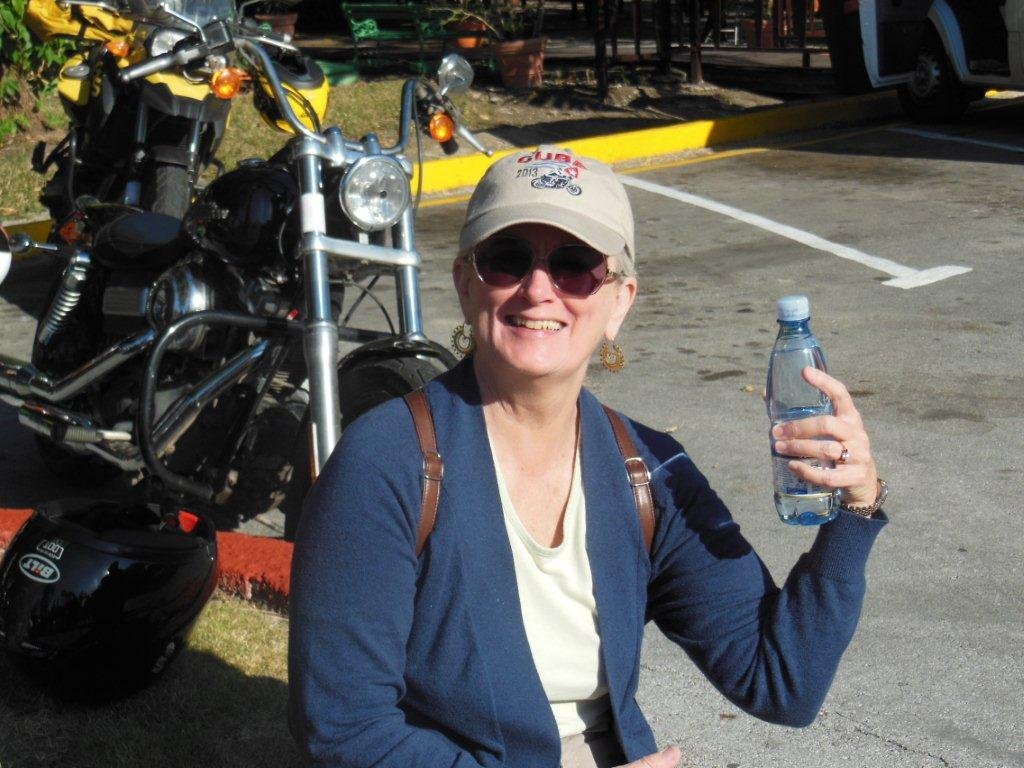
Above: Susan in Santa Clara, Cuba - 17 March 2013.
Susan is widowed spouse of Bob M. Like Mwah (sic), Bob worked for Citigroup during the 70's and 80's We were assigned to different parts of the organization so we didn't have the chance to meet while working there.
I met Susan for the first time in Chicago at Isetta's 70th birthday party three years ago. I enjoyed getting better acquainted with her on this trip.
Susan has been a close friend of our ride organizer Isetta since the late 1990's when her husband Bob and Isetta became motorcycling mates.
Though not today a motorcyclist, Susan acknowledges some motorcycle experience of her own. She and Bob, who met as Peace Corps volunteers in Columbia in the 1960's, rode together on their own "Motorcycle Diaries" expedition (also early 1960's) on a Honda 300 cc motorcycle from Panama City to Los Angeles.
Susan's husband Bob died when struck by lightning while on his motorcycle near Manatou Springs, CO in 2003.
Susan now divides her time between homes in St. Augustine, FL, St. Luis Obispo, CA, and Chicago, IL. She enjoys spending time with children, grandchildren and friends.
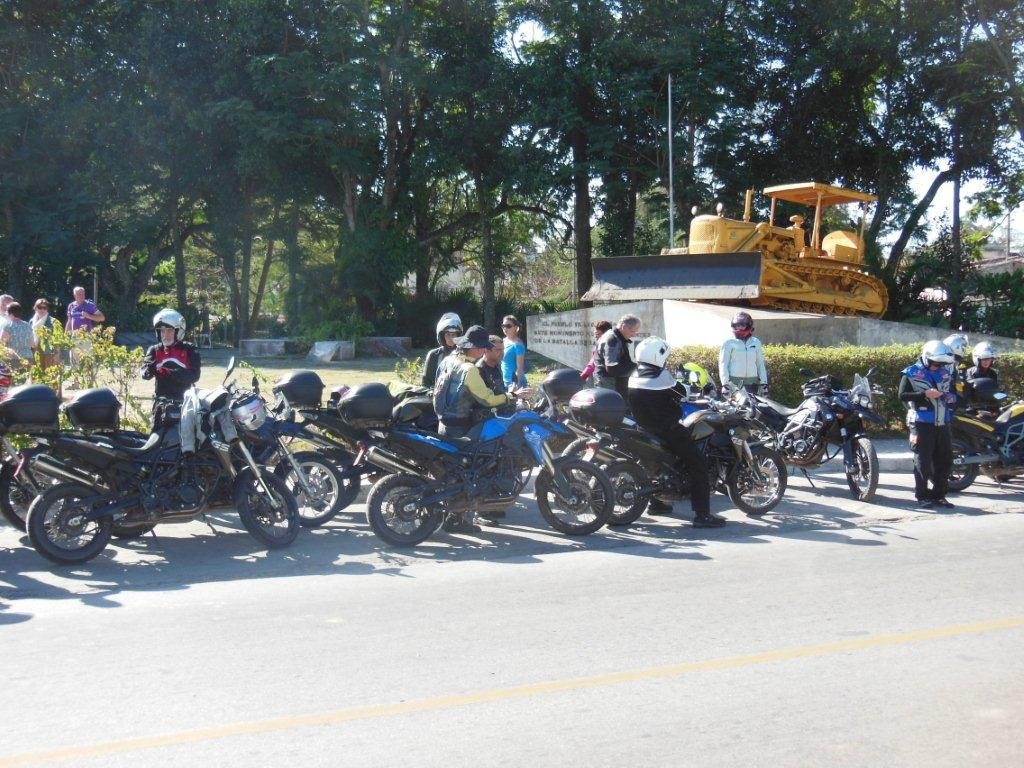
Above: 17 March 2013. Our motorcycles parked in front of bulldozer used by Che Geuvara's revolutionary guerilla insurgents to derail a train containing government troops, on 01 January 1959.
Guevarra reached Santa Clara on 28 December 1958 with only 300 rebels. He sent 23 of them, calling them "the suicide squad," to derail the government train.
Sensing defeat after the derailment, the government troops left the train and surrendered. Some of the government troops even signed up, then and there, to fight with Che.
The capture of Santa Clara is viewed as the definitive turning point of the Cuban revolution. Batista left Cuba twelve hours after the city's capture.
After Santa Clara, Che Geuvarra became a hero to revolutionaries throughout the world...

Che Guevara, after the battle of Santa Clara, January 1, 1959

Above: Horse drawn taxi. Santa Clara. 17 March 2013.

Above: Cartoon on Santa Clara city wall depicting the "futility" of "American military adventurism." Cartoonist undetermined. 17 March 2013.
Is there a lot of censorship in Cuba, and how do you deal with censorship? What (if any) are subjects you cannot draw about?
Adán: Of course there is censorship. I do not think there is a country where this is not present. In the Cuban case it has its peculiarities. On of the criteria for the press is that everything published should have an eductional value; many topics are not published because they supposedly lack this educational value. Some of these topics, in my experience are: religion, racism, homophobia. But
there are others that are difficult to classify, and cartoonists are sometimes clever in the way they subtly include topics in their work.
Adán Iglesias Toledo, Cuban political cartoonist, Cartoon Movement Blog, February 2013
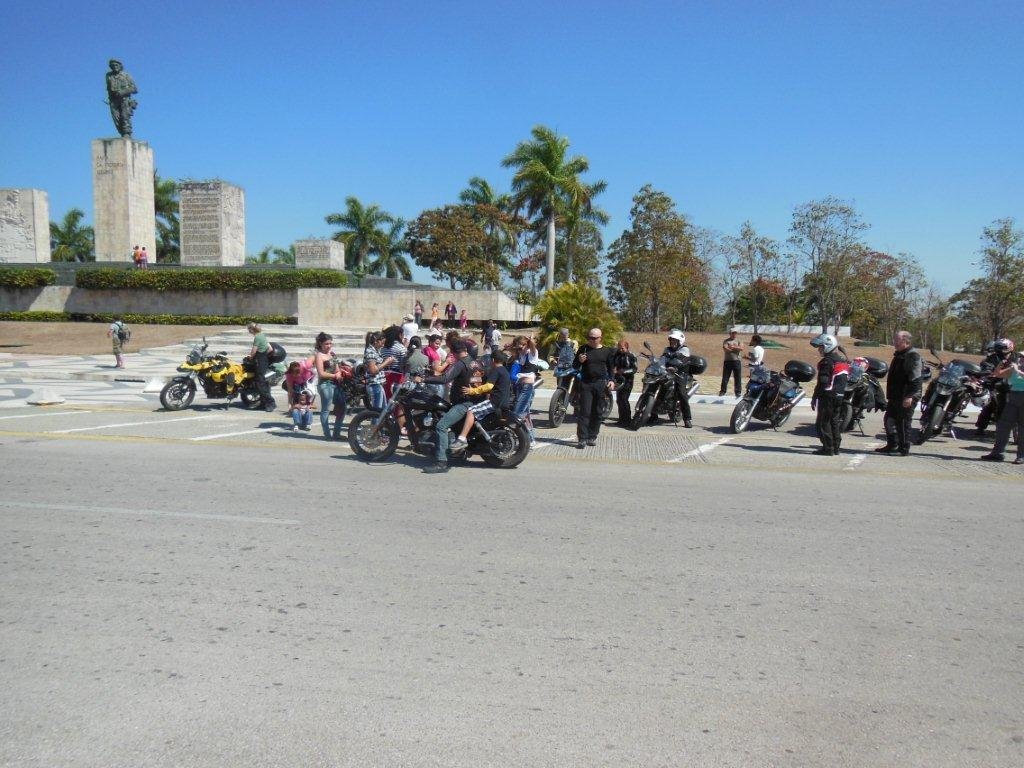
Above: Bikes, riders and the curious in front of the Che Guevara Memorial in Santa Clara, Cuba. 17 March 2013.
Che is ubiquitous in Cuba. Signs showing his image and his motto, "Always toward victory!" appear at the entrance to most cities and towns. At tourist spots, books about Che, t-shirts with Che's image, predominate as items to buy.
From Wikepedia:
Ernesto "Che" Guevara (Spanish pronunciation: [ˈtʃe ɣeˈβaɾa];[7] June 14,[1] 1928 – October 9, 1967), commonly known as el Che or simply Che, was an Argentine Marxist revolutionary, physician, author, guerrilla leader, diplomat, and military theorist. A major figure of the Cuban Revolution, his stylized visage has become a ubiquitous countercultural symbol of rebellion and global insignia within popular culture.[8]
As a young medical student, Guevara traveled throughout South America and was moved by the poverty, hunger, and disease he witnessed.[9] His burgeoning desire to help overturn what he saw as the capitalist exploitation of Latin America by the United States prompted his involvement in Guatemala's social reforms under President Jacobo Arbenz, whose eventual CIA-assisted overthrow at the behest of the United Fruit Company solidified Guevara's political ideology.[9] Later, while living in Mexico City, he met Raúl and Fidel Castro, joined their 26th of July Movement, and sailed to Cuba aboard the yacht, Granma, with the intention of overthrowing U.S.-backed Cuban dictator Fulgencio Batista.[10] Guevara soon rose to prominence among the insurgents, was promoted to second-in-command, and played a pivotal role in the victorious two-year guerrilla campaign that deposed the Batista regime.[11]
(end Wikepedia)
Castro offered Che senior positions in the new government, but, Che, ever the revolutionary couldn't sit still. He traveled to the Congo to participate in revolutionary movements. He was killed in 1967 while mounting a revolutionary effort in Bolivia.
Castro built a large army and in the 1970's followed in Che's military adventurism footsteps by sending troops and medical doctors to support revolutionary activities in Angola. From w.Militaryhistoryonline.com
Castro in Africa: Cuba's Operation Carlotta, 1975
by Russ Stayanoff, MA
On December 2, 2005, Cuba's aging Fidel Castro addressed his nation's armed forces in his last personally delivered Revolutionary Armed Forces Day speech in Havana. The speech commemorated the 30th anniversary of the Cuban army's Angolan intervention.[1] The speech was the archetypal "Castronic" socialist diatribe long-time Fidel watchers had come to expect. However, during this speech Fidel, for the first time, shed some light on the history of the secret deployment of some 36,000 Cuban troops, sent in 1975, to defend the newly declared independent Marxist government of Angola. "Never before," declared Fidel, "had a Third World country acted to support another people in armed conflict beyond its geographical neighborhood." The Cuban leader declared that contemporary historical assessments of the region consistently omit the contributions of the Cuban expeditionary forces. Castro called the contributions of the Cuban army "decisive in consolidating Angola's independence and achieving the independence of Namibia."[2]
We visited a very interesting museum at the Che monument. The museum possessed many of Che's original letters, and personal effects.
I was among the first of our group to return from the museum to the motorcycles. Standing, observing the bikes, were about ten teenage girls and two adult women.
"Familla?" I asked. "Si," one of the older women replied. "Por que non ninos?" I inquired. By that time, Luis, our Cuban ride leader had approached and he translated the reply: "We left the boys home!" followed by the laughter of all the girls.
The girls said where they were from (not from the local Villa Clara province) and we said where we were from. Smiles all around. Before long, Luis, was giving each of the girls a ride on his Harley Davidson motorcycle.
The encounter with the girls affirmed once more to me that, in general, people around the world have a high regard for Americans. Cuba is the 107th country that I have visited. I have lived in 7 countries outside of the United States over a period of 20 years and have generally found that people hold Americans in high regard.
It needs to be remembered that many, if not most, Cubans have relatives living in the United States. For that reason alone...not to mention base ball...Cubans are predisposed to like America and Americans.
I do acknowledge that about 30 thousand European bureaucrats, 10,000 Islamic terrorists, 10,000 US college professors, and 5,000 members of the US media do not hold Americans in high regard.
I am reminded of having heard Fuad Adjami, middle east expert resident of the Hoover Institution at Stanford University, speak to a group I was part of at Hoover last October. Adjami said, that by and large Arabs hold Americans in very high regard. They may outwardly say, "go home, Yankee," but, in the same breath they will whisper to you, "and take me with you!"

Above: Sugar manufacturing machinery. Museo de la Agroindustria Azucarera, Villa Clara Province, Cuba. 17 March 2013.
When sugar production is abandoned, the machinery becomes an art piece.
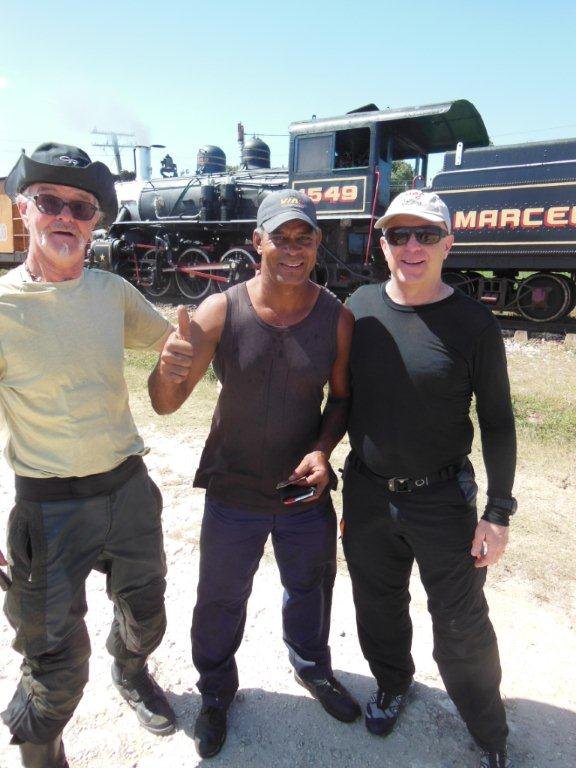
Above: Crocker, Rolando, Joe in front of working sugar train locomotive. 17 March 2013.
Rolando, locomotive engineer, was just rolling his tourist sugar train into the railroad yards when we arrived. After depositing his tourist passengers, (we weren't scheduled for a train ride), he blew the whistle of his huff puffing steam locomotive, waved to us, caused the locomotive to belch out a load of smoke, and laughed.
It was a spectacle. There are not many opportunities any more to see a functioning steam locomotive. We watched the steaming, belching locomotive with glee.
Rolando jumped out of the cab of the locomotive and ran over to me. He said in broken English, "you moto?" "Yes," I answered. He handed me the business card of one of the operatives of the Danish company that owns our motorcycle fleet..not Mike, with whom I had dined several nights previously, but, likely one of his compadres (Spanish, heh heh). I smiled, as others gathered around to see what was up.
Then, Rolando, invited the four of us standing there to mount into the cab of the locomotive. We did. What fun! Four kids blowing the whistle of a steam locomotive!
Like the women and the girls at the Che monument, Rolando seemed very pleased to be bantering with us gringos.
At other points during the trip, I would be standing, perhaps waiting for the bikes to be refueled, and someone would walk up to me and ask, "where are you from?" "US," I would reply. Invariably the response, delivered with a broad smile, would be something along the lines of, "Bueno! You are welcome here!"
I have experienced discomfort as an American in being around certain peoples. When visiting Russia in 1964 I remember the Russians - then - as not being particularly threatening, but also not particularly friendly. This was at the height of the cold war and I surmised at the time that the Russian antagonism I experienced was a state ordered attitude.
Still, just six months previously, I had met some Russian engineers working on the new Nile dam in Aswan, Egypt. They invited me to tour the turbines under construction at the Aswan Dam. They were very friendly and thought it fascinating that they were escorting an American around the dam construction.
Later in 1964, friends and I were riding a bus from Damascas to Baghdad. Most of the passengers on the bus were Muslim pilgrims who barely looked at us, let alone talk to us, during the entire twenty four hours taken to make the journey. It was not until near the end of the trip that the Imam leader of the pilgrims, turned around from his seat in the front of the bus, grinned, and nodded his head in our direction. Immediately all his charges turned around, smiled and nodded accordingly.
To be sure, it was pretty unusual to see four American students traveling third class overland bus in those areas at that time. Maybe the Imam can't be blamed for his suspicions. But, we behaved well and the Imam, at the end of the trip seemed to acknowledge that we weren't a threat to his flock.
Crocker and his wife Ester, also on the Cuba trip, and riding pillion behind Crocker, are vintners on the north coast of California, between Artisia and Eureka. Crocker, riding a vintage BMW 800 GS, attended my last Big Cat ride in San Pitch, UT 2006. We have skied together and ridden together on other international motorcycle rides... Turkey for one.
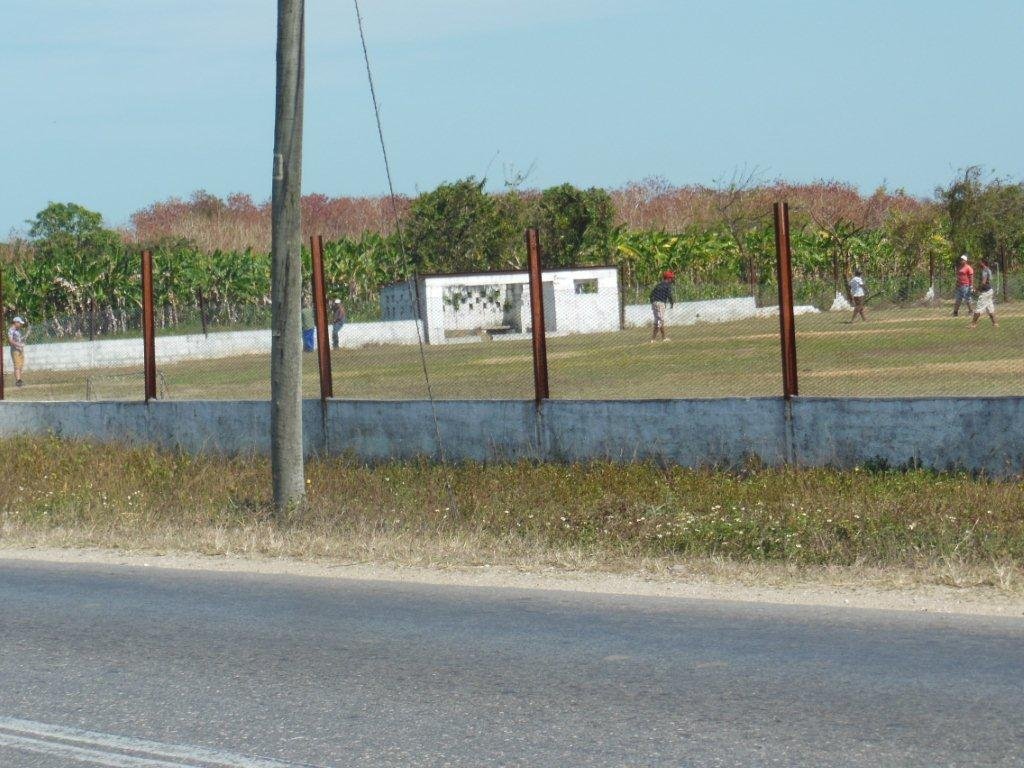
Above: Pick-up beisbol game on field in rural Villa Clara Province, Cuba. 17 March 2013.
Beisbol made its entry into Cuba in the late 1850's by way of Cuban students who were returning home after having spent a few years in different US cities.
By 1875, baseball fields and organized teams are known to have existed in Havana. Since, the sport has been dramatically and massively adopted by the Cuban people.
The Base Ball field in Cuba will disappear after the cockfighting pits and the bullrings because it has become firly rooted in this land, as evidenced by the hundreds of clubs that are constantly being organized on almost the entire island.
Wenceslao Galvevez, Cuban baseball historian
... if there are two forms of expression that are capable of defining us to ourselves and to the world, one of them has been music - recognized all over the world - and the other is the game of baseball... which for Cubans is much more than a game. It is a passion...
Leonardo Padura Fuentes
The US major leagues are noted for such currently active Cuban stars as Aroldis Chapman, Jose Contreras, Alex Ramirez, Yunel Escobar and Kendry Morales.
For national competitions, Cubans are unable to draw on these major league players to fill out their national team, unlike The Dominican Republic, which uses its pro players on the national team. The Dominican Republic won the 3rd Baseball World Classic just this week.
As we rode through rural Villa Clara it seemed that each small town had a base ball field or stadium.
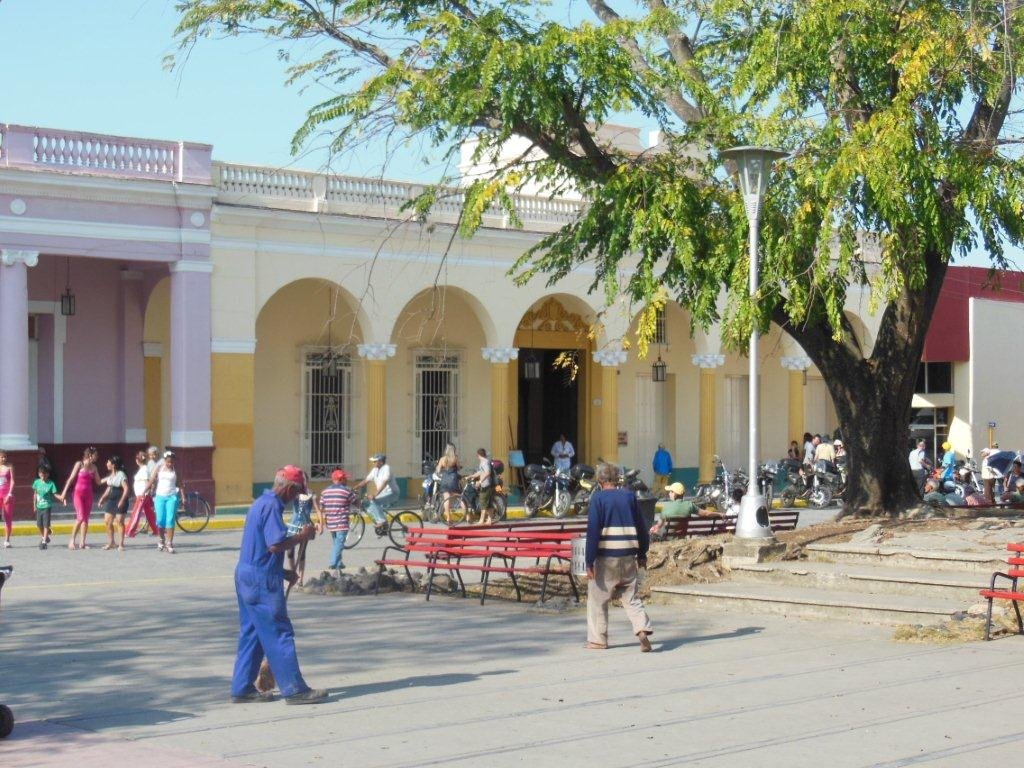
Above: Pre revolution, colonial home on the main square of Santa Clara. The home, after having been taken from its owners by the revolutionary government, has been turned into a museum: Museo de Artes Decorativas. 17 March 2013.
Maria Magdalena Hernandez was the docent in charge. She divided us into two groups to see various art pieces displayed in the old home and collected from the Villa Clara area.
In the home's courtyard, senior citizens formed a band playing pre revolution numbers on antique musical instruments. Cuban senior citizens also danced to the music emulating a side of Cuban culture, now lost, but still remembered.
It is odd to be in a place where nothing seems new... all seems old. Old cars, old furniture, horse drawn taxis, almost exclusively old buildings. Most of what we have been shown today seems to celebrate the traditions of pre-revolution Cuba. Are we seeing a subliminal yearning on the part of Cubans for things past? Or is there just nothing else to show us?
New construction virtually stopped after the 1959 revolution. Apart from some dour Soviet style sky scrapers and tenements in Havana, and a few foreign joint venture hotel projects, nothing is new or contemporary. Note: There is a group of new Cuban architects that are starting to do some imaginative work in the slow, but discernibly liberalizing climate. I haven't seen any evidence of new architecture on the tour, however. New building will be required. We have been told that one or two buildings collapse daily in Havana.
For me it is some what depressing to see time having stopped for a couple of generations of Cubans. If Cubans seems to be celebrating their past, perhaps that is because the past is all they have.
Yet, the spirit of the Cubans we encounter does not seem to be diminished. Cubans appear to be resourceful in using the little that they have. Their keeping the old American and Russian cars on the road is a sign of this resourcefulness. The people seem happy in their penury. They are uncommonly friendly, cheerful and outgoing...voire today's experience we had with the girls at the Che monument. I think their music has been an outlet to compensate for their otherwise penurious circumstances. Communism can, as we have seen throughout the world, destroy economic growth... but, so it seems, it has not destroyed the spirit of the Cuban people.
Though Cuban access to the outside world, because of internet restrictions, government censorship etc. is limited, Cubans seem eager to engage with the growing number of foreign tourists visiting their country. As the tourist industry brings heretofore unimaginable prosperity to some, others will yearn. Our "people to people" contact with Cubans is a chance for them to get a sense of their participation in a "globalizing" world.
A caveat.
Squeezed economically, and for space, post revolution Cubans, otherwise Catholic in their childbearing proclivities, have stopped having large families. The current birthrate in Cuba is less than 1.5 births per fertile female. 2.1 births is "population replacement." Economic growth may be harder to achieve, notwithstanding a relaxation of onerous government strictures, if there are not enough workers to create the growth and support a disproportionately aging population.
Defenders of Cuba would say that yes, the country has economic problems... but, it also has created a literate population and has one of the best medical care systems in the world. Cuba does more organ transplants per capita than any country in the world.
Cuba may find that there is a silver lining in the disproportionate number of highly qualified, but, poorly paid, medical doctors. Medical tourism. As quality medical care in the US becomes harder to obtain, getting a hip replacement or an organ transplant in Cuba at one tenth the cost of a US procedure may be attractive to a growing number of Americans unsatisfied with the quality and cost of their own care options. Just Mwah (sic) sayin'.
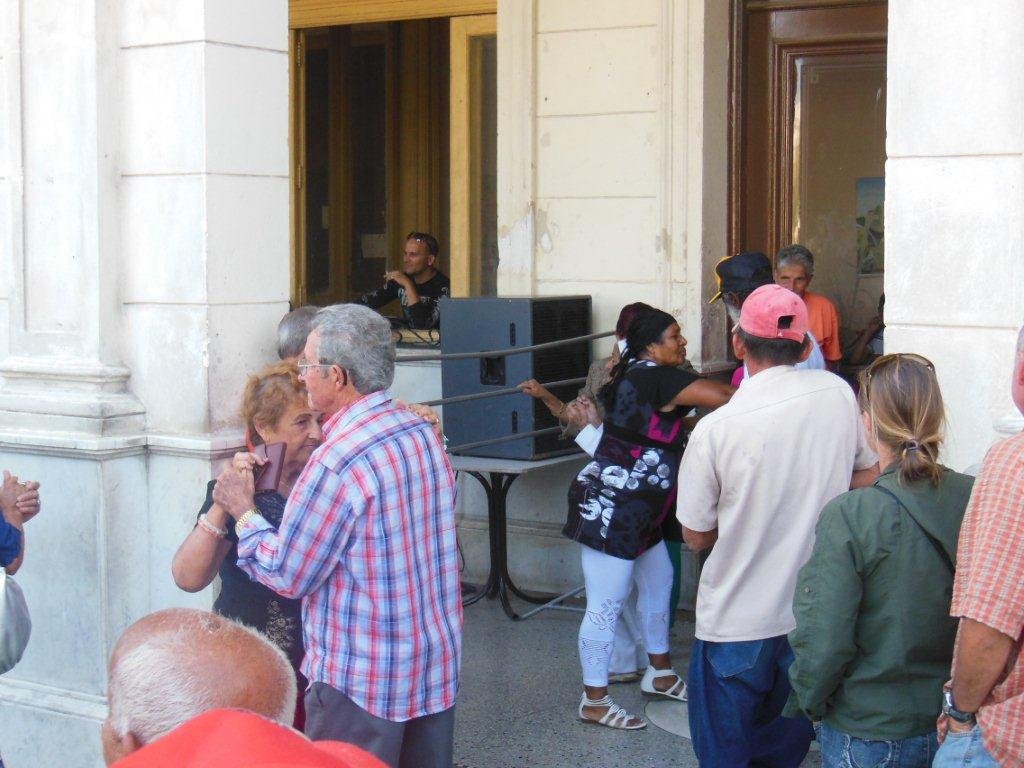
Above: Dancing in the Streets... Cuba style. 17 March 2013.
I can't emphasize enough how much the rhythmical, syncopated, Cuban salsa beat seems to pervade wherever we travel.
Here on Sunday afternoon in the main square of Santa Clara, a Cuban band, located on a hotel veranda, was pumping out rhythms and locals of all ages were out there boogyin' (sic).
Addendum:
Cigar's ,please show photo's of you enjoying one with your cocktail in the eve! What is your drink of availability ?
Marko,
Ojai, CA
You know very well that I don't smoke cigars.
Full availability of spirits found in any bar internationally. Decent wine lists.
Cubans have learned to cater to tourists... and alcohol prices at bars are reasonable.
Available are some Cuban spirits not permitted in US due embargo: Havana Club Rum, Santiago Whiskey.
Steve,
Each day is more interesting than the last. Great insights! Can’t wait until the next entry!
linda, Miami FL
18 March 2013 - Cuban Entrepreneurs
We rode our motorcycles... about 110 miles, from Santa Clara over the Sierra Maestra mountain range, to Trinidad.
From Wikepedia:
Tourism officials like to say Trinidad is a museum in itself. Those visiting the 500-year-old city will find Spanish colonial architecture, underscoring a colonial ambiance that marks the tiny city one of the country’s greatest attractions. Only a few square blocks in size, historic Trinidad is famous for its lovely, cobblestone streets, pastel coloured houses with elaborate wrought-iron grills, as well as beautiful palaces and plazas. The city can be toured in a few hours, by foot or by horse-drawn carriage. The city is located near both the Escambray Mountains and the Caribbean coast.
One of the area’s notable sights is the Valley of the Sugar Mills, which has been declared a World Heritage Site. The valley has around 70 long-standing sugar mills which serves as a reminder of the importance of sugar to the Cuban economy over the centuries. It has la Torre Iznaga, a 45 meter tower built by Alejo Iznaga Borrell in 1816. Twenty km from the city is Topes de Collantes, one of Cuba’s premier ecotourism centres. Another attraction is the Casilda Bay, which attracts both snorkelers and divers. A nearby islet has pristine beaches.
Ancon Beach is a white sand beach which was one of the first new resorts to be developed in Cuba following the 1959 revolution. Along the Ancon Peninsula are three hotels: Hotel Costa Sur (South Coast Hotel), Hotel Ancon and Brisas Trinidad del Mar (opened in 2002)
There are several world class casas de musica, and every night next to the church in plaza major is one of Cuba's busiest dance floors. There are also excellent discothèques, one in a church ruins the other in a huge cave once used as a war time hospital.

Above: Luis Enrique Gonzales Saez. 18 March 2013.
Luis was our ride leader. He is the head of the Cuban Harlistas, a group some 200 strong of Harley Davidson owners in Cuba.
He works closely Mike of XpeditDK.com (Copenhagen) to manage the fleet of motorcycles (BMW's and Harley Davidsons) used for motorcycle tours in Cuba. Luis, is a collector of vintage Harley Davidson motorcycles. And, he is the ride leader of many of the Cuban motorcycle tours (when XpeditDK.com has more than one tour going, Mike is the ride leader of the second tour).
Luis, working mainly in the tourist industry, is a member of the putatively growing, private, entrepreneurial class of Cuba.
Luis knows the roads, knows the terrain, and, as a Cuban, is in tune with local mores that otherwise might be obscure to the visiting motorcyclist.
The riding MO of our tour seems to keep us clustered pretty close together as we follow Luis, who alone, amongst the group, rides a new model Harley Davidson motorcycle, part of the fleet XpeditDK.com imported to Cuba from Denmark. As I mentioned in an earlier diary entry, the rest of us are riding BMW F800 GS or F650GS dual sport motorcycles, supplied by XpeditDK.com of Copenhagen, Denmark.
Tour leader, Juan Stanglmaier rides sweep on a BMW F800 GS motorcycle. The back up van follows the pack. The van carries, tools, tires, our luggage, Susan, sometimes one of the spouses who is taking a break from riding pillion, representative of Cuban tourist authority, Adrian, and driver Roberto.
On some tours of this nature, at the day's start, riders are given a destination address and directions; the motorcycle riders spread out, riding at their own pace, and have considerable flexibility about what they do between the ride start and the ride destination... though they are always admonished to stay on a certain route and/or to park their bikes conspicuously to make sure the back-up van doesn't pass them without seeing them.
Riders on our Cuba trip were not given addresses and directions to the destination so the MO was to stay close to either Luis, Juan, or the van to make sure you arrived at the right destination.
Luis either made planned stops... or in some cases, spontaneous stops if he saw something he thought would be interesting for the group to see.
It was possible to stop on your own, with the cluster continuing to move forward, if something interesting attracted your attention. Juan, or the van, would pull up behind, and wait until you started up again.
Riders ahead were good to stop at intersections where the lagging rider might otherwise have difficulty deciding which way to turn. This is good group riding protocol in any case.
Were group riding protocol not followed, the lagging rider would be able to determine from either Juan or Roberto, one of whom was always behind him, which direction to turnk.
On this ride, Luis and the sweep motorcycle or van have never been separated by more than three or four minutes.
As a general rule, I prefer the "here's your destination and directions, please be there by 5 PM," approach to group tours. Such a riding method might have provided more opportunity for spontaneous "people to people" interaction with Cubans. As it was, because we were more or less clustered together, most of our people to people interactions seemed to occur during the programmed stops of the tour, with Luis, or Juan nearby. This was not necessarily a bad thing, as all Luis' stops, programmed or not, added considerable value to our Cuban riding experience.
Luis did an excellent job leading, determining fuel stops, and otherwise keeping the fleet in good working order. We were in good hands.
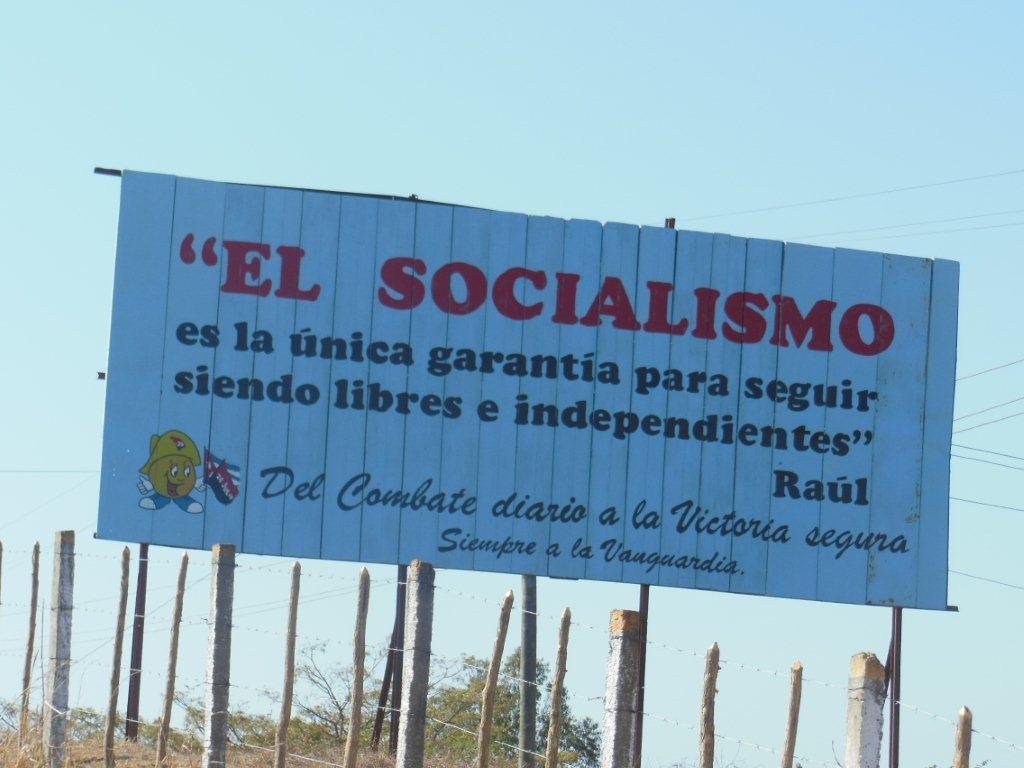
Above: Typical of signs seen along the route... usually at the entry to a town. 18 March 2013.
No commercial advertising. In Cuba, it seems, only Raul, Fidel, or Che get to talk to the people via billboard.
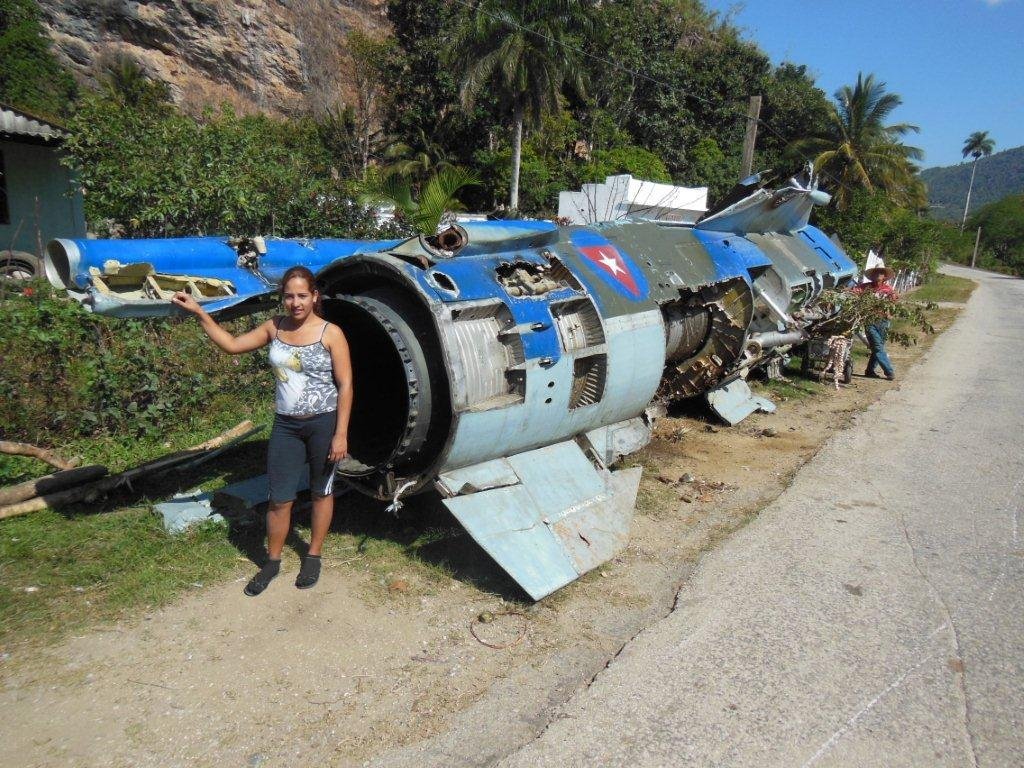
Above: Mildred poses in front of cannibalized MIG 23BN along the route in the Sierra Maestre Mountains between Santa Clara and Trinidad. 18 March 2013.
Mildred's father had acquired this jet to strip it of its aluminum, melt and cast the aluminum into ingots or other shapes for resale.
We were invited into the atelier cum house to see how the operation worked.
The cottage industry aluminum smelting operation is an example, unusual to be sure, of what we are told is a growing tolerance to allow for entrepreneurial, private initiatives in the Cuban economy.
There is an interesting story behind the plane, now a hulk, in the above image.
On 20 March 1991, Cuban Major Orestes Lorenzo Perez defected in his MIG 23BN to Naval Air Station Key West, Florida while on a training mission of the Cuban air force. On 19 December 1992 he returned to Cuba in a small, twin-engined 1951 Cessna 310, landing on the coastal highway of El Marney beach in Varader, Matanzas Province, 93 miles from Havana at the agreed time. His wife Victoria, and their two sons, Reyneil and Alejandro were already waiting on his order delivered through two Maxican ladies as messengers a few days before. Perez picked up his family and managed a successful safe return to Marathon, Florida. The MIG-23 BN was returned by US authorities to the Cuban Air Force. Mildred's family claims that the cannibalized jet shown in the image is the jet used in Perez' defection. It was not clear how the family acquired the jet.
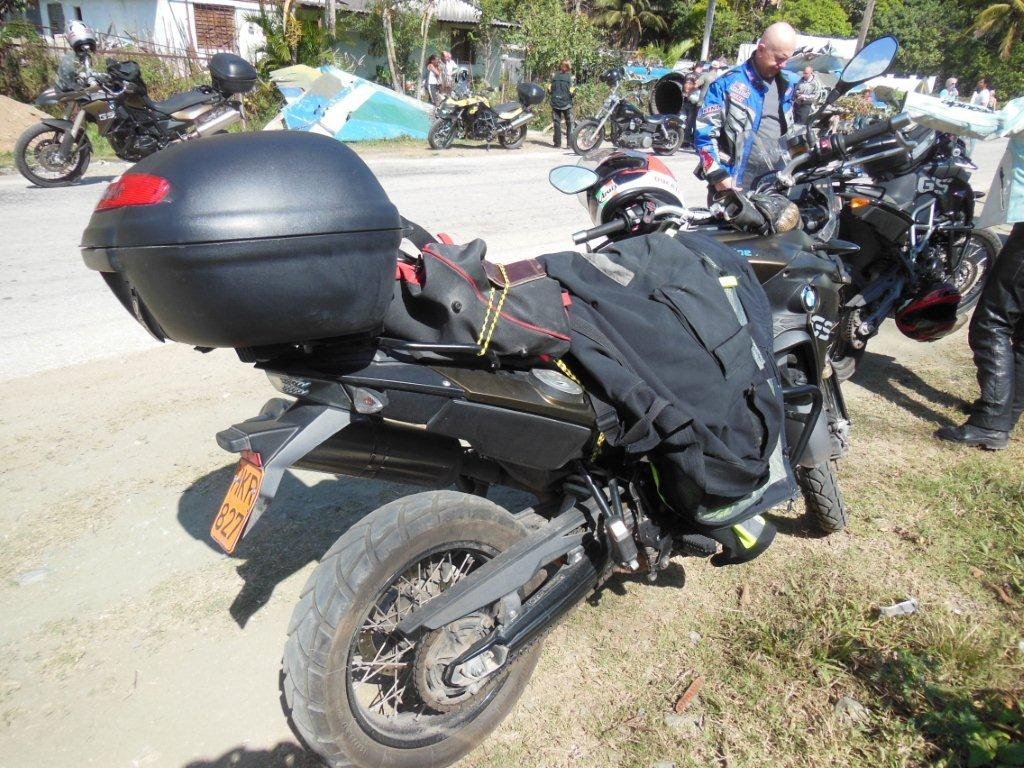
Above: BMW F800 GS motorcycle. 18 March 2013.
This bike is the one I was riding, my gear is draped over the seat as the bike is parked near the MIG cannibalization operation we stopped to observe.
The F800 GS is a dual sport motorcycle. It rides high above the ground to allow for riding on irregular, unpaved surfaces as well as highway.
I purchased one of these bikes last summer and rode it on dirt and rocky trails in the Wind River mountains of Wyoming (Big Dog Ride) and in the Uintah mountains of Utah before the winter snows came.
We did very little off tarmac riding on this trip... only a couple of stretches that were under construction and unpaved.

Above: While stationary, looking in the rear view mirror at a uniformed horseman approach from behind. Sierra Maestra Mountains. 18 March 2013.

Above: Lake view in Sierra Maestra Mountains. 18 March 2013.
It was in these mountains, which rise to about 7,000 feet, that Castro's revolutionary guerrillas hid for two years between 1956 and 1958, before taking their fight to the lowlands and, under Che's direction, capturing Santa Clara on 01 January 1959.

Above: Jose Munoz. 18 March 2013.
Joe Munoz is one of Trinidad's most dynamic and charismatic personalities. Hors-whisperer...photographer...raconteur... electronic engineer. He is a member of Cuba's growing entrepreneur class.
For a programmed "people to people" experience, our group was invited into the Munoz home, now a bed and breakfast (Casa Particular), by Julio and his wife Rosa, where we listened to Jose share his knowledge about Trinidad and Cuba today.
Munoz noted that his home came to him by inheritance. His family has lived in Trinidad for over two centuries.
Julio said that the Cuban government has recently been relaxing regulations and controls for entrepreneurs such as himself. He noted that he felt that he could be a successful businessman in Cuba while operating within the law.
His website:
http://www.trinidadphoto.com/

Above: Floor tiles at Casa Particular (Munoz home). 18 March 2013.

Above: Trinidad street. 18 March 2013.
Trinidad, Cuba bills itself as the most preserved colonial city in America. It is designated as a UNESCO World Heritage Site.
Juan told us in Havana that while Trinidad was on our tour, he had been unable to secure hotel reservations for us there. He noted that rather than by-pass what is one of Cuba's most interesting city's he would attempt to secure private residences for us as a place to stay.
Racing Shock and I shared an empty residence, two bedrooms, on this street, just beyond the tree seen half way up the street on the right.
The modest exteriors of the homes belie what's inside... a 2000 square foot house to include kitchen, two bedrooms, one bath, a sitting room and an outdoor courtyard. The furniture and fittings in our house were Spartan, but clean. Fully plumbed, hot water, TV, fridge... what more does one need in life? Oh yeah... no wifi.
The owner of the house was Darnell... who had a twin brother... Jamelle, who was a truck driver in Tampa, FL.
Darnell (early thirites) lived with extended family next door... he was unmarried. Asked what he did for a living, Darnell said he managed the house in which we were staying.

Above: Vista Gourmet Restaurant, Trinidad. 18 March 2013.
Private restaurant. Eatin' good in the neighborhood.
Trinidad was full of tourists.
The "fine dining" in private restaurants has been at international standard in cuisine and service. The fine dining availability is one of the surprises of the trip.
Some of the group went out to some music night spots. I was beat and went to my Trinidad home to bed.
Viewing your photos and reading your insights are taking the sting our of the pain of having to say goodbye to you and your friends at the airport in Miami. How I wished I could have joined you.
Thank you so much for sharing.
Skip Mascorro
MOTODISCOVERY
San Antonio, TX
s Thank you for sharing . . fascinating !
Mano,
San Diego, CA
thanks. good stuff .
Brand Man,
Venice, CA
19 March 2013 - Trinidad to Havana
We rode from Trinidad, via Cienfuegos and the Bay of Pigs, to Havana... about 130 miles.

Above: Darnell and Shock. Courtyard, Darnell's Trinidad, Cuba house. 19 March 2013.
Darnell is the owner of the Trinidad house where Shock and I spent the night of 18 March 2013.
Here, he is shown with breakfast he brought from next door, where he lives with extended family.
Trinidad bursts at the seams with tourists, and homeowners like Darnell have converted their homes to B and B's. Darnell notes that the B and B process is highly regulated. He must review our passports, note down our names and passport data in a log, and present the log to the local government tourist authority.
Shock is a long standing riding friend. We have motorcycled together in Turkey, Ethiopia, and Southern Africa for starters. Shock is CEO of the firm, Competition Tire, which manufactures and markets high performance shock absorbers. Shock counts NASCAR (70% market share) and Formula One race teams amongst his customer base.
Shock is forced to work week ends to attend races. At the races, he is compelled, using his full access pit pass, to toil in the noisy pits meeting with customers. Shock is a close associate of Roger Penske, who used to own Competition Tire.

Above: Fueling up in Trinidad gas station. 19 March 2013.
1956 Ford Fairlane represents the old, contrasted with the new motorcycles.

Above: Motorcycle Tourist and Cuban bystander at Trinidad gas station. 19 March 2013.
While waiting for my turn at the fuel pump I noticed this local observing the observation. My eye was drawn to the wording on his T-shirt: Salt Lake City.
Wha???!!! A Salt Lake City T-shirt in Trinidad, Cuba?
I walked over to the man, pointed to the writing on his shirt and then to myself and said, "my city!"
I asked the man if he would pose for a picture with me and he agreed.

Above: Barnyard scene. 19 March 2013.
On the road from Trinidad to Cienfuegos.

Above: Bay of Pigs beach. 19 March 2013.
Wikepedia:
The Bay of Pigs Invasion, known in Hispanic America as La Batalla de Girón, was an unsuccessful military invasion of Cuba undertaken by the paramilitary group Brigade 2506 on 17 April 1961. A counter-revolutionary military trained and funded by the United States government's Central Intelligence Agency (CIA), Brigade 2506 fronted the armed wing of the Democratic Revolutionary Front (DRF) and intended to overthrow the revolutionary leftist government of President Osvaldo Dorticós Torrado. Launched from Guatemala, the invading force was defeated by the Cuban armed forces, under the command of Prime Minister Fidel Castro, within three days....
...The failed invasion strengthened the position of Castro's administration, who proceeded to openly proclaim their intention to adopt socialism and strengthen ties with the Soviet Union, leading to the events of the Cuban Missile Crisis in 1962. The invasion was a major embarrassment for U.S. foreign policy, with Kennedy ordering a number of internal investigations. Across much of Latin America, it was celebrated as evidence of the fallibility of U.S. imperialism.

Above: Rice field near Cienfuegos. 19 March 2013.
Wikepedia:
Rice plays a major role in the Cuban diet. Rice in Cuba is mostly grown along the western coast. There are two crops per year. The majority of the rice farms are state-farms or belong to co-operatives.[19] Cuba has been a major importer of rice. Recently, the annual rice imports have approached 500 000 tonnes of milled rice. The production of rice is limited due to the shortage of water and similar to other industries in Cuba the lack of fertilizers and modern agricultural technology. The yield per hectare remains lower than the average of Central American and Caribbean. countries.[20].
Cuba spends about 2 billion dollars every year in importing food.
The inefficient agricultural industry in Cuba has led to the need to import large amounts of foods.[2] Cuba now imports about 80% of the food it rations to the public.[2] The rationing program accounts for about a third of the food energy the average Cuban consumes.[3] Overall, however, Cuba is dependent on imports for only 16% of its food. [4]

Above: Cienfuegos as seen from sidewalk cafe. 19 March 2013.

Above: Band and dancer. Cienfuegos sidewalk cafe. 19 March 2013.
The music never stops.

Above: Our dinner restaurant in Havana historic district. I lost my notes giving the name of the restaurant... but, lobster was the principal fare. 19 March 2013.

Above: Granma (yacht) at Granma Yacht Memorial in Havana. 19 March 2013.
A late night image, taken from a distance. Still, the outlines of the yacht can be discerned.
Wikepedia:
Granma is the yacht that was used to transport 82 fighters of the Cuban Revolution from Mexico to Cuba in 1956 for the purpose of overthrowing the regime of Fulgencio Batista. The 60-foot (18 m) diesel-powered cabin cruiser was built in 1943 and designed to accommodate 12 people. "Granma", in English, is an affectionate term for a grandmother; the yacht is said to have been named for the original owner's grandmother.
Fidel Castro and Che Guevara were amongst the 82 passengers on Granma's revolutionary voyage.
Addendum:
I believe the DOGS will find your tour interesting, some never having ventured outside the USA.
Sidebar: Love watching Cyprus stealing the foreigner's deposits. Of course, the USA is stealing money from anyone holding dollars by printing more paper every day, watering down the value. I was getting 31 here for a dollar when I arrived in Oct. Now just above 29. Was 44 when I first came here 8 years ago..... Poor fookers who retired here on their SS or limited retirement have been sucking wind....
Dr. G,
Someplace in Thailand
Thanks Steve.
The Monk,
Salina, UT
Terrific, best summation of history and life in Cuba that I have read. Thank you for your efforts, most appreciated.
Mezz,
Miami, FL
FYI--from start to finish Major Perez’s rescue of his wife and kids from Cuba to Florida took just under 100 minutes which is memorialized in 100 Minutes to Freedom written by David Savold.
I continued to be fascinated by your Picto Diaries and I look forward to future reports. Thank you
Captain Kirk, Park City, UT
20 March 2013 - Havana... on return
Last night we handed over the keys to our motorcycles.
Today, we switched from motorcycles to antique American convertibles.
We toured residential Havana areas, Marina Hemingway and visited the home of Luis, our ride leader and Harlista president.
Afternoon to relax and then dinner (La Guardia) and a night on the town (Tropicana).

Above: Members of our group, standing in front of Quinto Avenida Habana hotel receive a briefing on the up coming day. 20 March 2013.
Standing at the center, wearing brown shirt and blue jeans is Taos. Taos is a retired business consultant from Chicago (Accenture) and lives with his wife Kim Novak, also from Chicago, in Taos, NM. Taos is a regular, expert skier, at Taos ski resort. Taos, Kim Novak, and Mwah (sic) have been on a number of international motorcycle trips together.
Standing closest to the bus, in the northeast quartile of the image... green shirt and tan cap, is Tony. Tony, a Brit, retired, lives with his wife in Languedoc, France. He is a Lambretta scooter collector and met our leader, Isetta, at a scooter/motorcycle rally in Italy ten years ago. I met Tony for the first time on this trip. Tony is planning to ride a Lambretta scooter from Cape York, Queensland to Sydney, Australia as part of an international Lambretta rally to be held next month (April).
In black, in the southwest corner of the image, is Luis, our ride leader.

Above: Artistic tile covered residence near Marina Hemingway, Havana, Cuba. 20 March 2013.
This house was artistically designed in tile by a local artist home owner. Other home owners in the neighborhood followed suit on their own homes, though they are not as ornate as this one, which started it all off.

Above: Our vintage auto motorcade at Marina Hemingway. Mwah (sic) captures the image while riding in a 1956 Ford Fairlane convertible. 20 March 2013.
These cars are truly vintage... meaning that they are powered by original engines.
A majority of the old American automobiles in Cuba have converted to newer, Russian made, diesel engines.
Paulo was the owner and driver of our car... a friend of Luis, our ride leader.

Above: Juan (our tour leader), Joan Cusak, and Chicago Ducati. Seated in 1956 Ford Fairlane convertible, Havana, Cuba. 20 March 2013.
Joan Cusak and Chicago Ducati are married and live in Chicago. They are world motorcycle adventurers... I last rode with them in southern Africa three years ago. Chicago Ducati is a regular ski visitor to Park City where we have connected two or three times during his, and his friends' visit.
Chicago Ducati is a real estate developer and does consulting work for Chicago motorcycle dealerships. Joan Cusak is a software engineer.

Above: Havana street where ride leader Luis' home is located. 20 March 2013.
We visited Luis' home to meet his family, view a very well made video on the Harley Davidson culture in Cuba... the Harlistas, and to check out Luis' collection of vintage Harley Davidson motorcycles.

Above: Art Deco bar in our second Havana hotel, Hotel Saratoga, located in downtown, historic, Havana. 20 March 2013.
Coincident with our visit to Cuba, the 12th World Congress on Art Deco is being held in Havana (14 to 21 March 2013).
Art Deco was introduced to Cuba in the 1920's.
A local Art Deco preservation group, Habana Deco Group, was formed in 2009, sponsored by the National Council of Cultural Heritage, and is made up of architects, PhD's in art, museologists and other specialists.
The Art Deco week will be attended by Art Deco experts from around the world and will involve a number of visits to and presentations about Art Deco gems in and around Havana.
Redux: It seems that everything of interest in Cuba is about the past.
I would have liked to see something more of what post revolution Cuba is said to have accomplished... their putatively good medical care system, for example.

Above: Havana scene at sunset. 20 March 2013.

Above: Overlooking courtyard in building in which our restaurant, La Guardia, is located. 20 March 2013.
La Guardia is considered to be one of Havana's top restaurants.
I ordered onion soup... similar to gratinee... but lighter in color, little bread, lots of chopped onions, and a lighter sprinkling (than grantinee) of Parmesan cheese. It was terrific.
The tilapia fish tacos seemed to be popular with many of our group. I ordered a steak, which was excellent.
The group around my area shared a couple of bottles of Malbec.
The frayed state of the classical architecture seen in the image above is a good metaphor for Havana itself. A relic of past glory.
Looking at Havana, I was reminded of how Calcutta, India looked when TIMDT and Mwah (sic) lived there in the early 1970's... then, Calcutta (now Kolkata) looked to be a city in an advanced state of decay... and so it seems also today with Havana.

Above: Our group celebrates Teeny Tiny's birthday at La Guardia, restaurant. 20 March 2013.

Above: Tropicana Club, Havana. After dinner entertainment. 20 March 2013.
Tropicana is a world known cabaret and club in Havana, Cuba. It was launched in 1939 at Villa Mina, a six-acre (24,000 m²) suburban estate with lush tropical gardens in Havana's Marianao neighborhood.
A Cabaret Guide issued in 1956 described The Tropicana as:
"the largest and most beautiful night club in the world. Located on what was once a 36,000-square-meter estate, Tropicana has ample room for two complete sets of stages, table areas and dance floors, in addition to well-tended grounds extending beyond the night club proper. Tall trees rising over the tables and through the roof in some spots lend the proper tropical atmosphere which blends well with the ultra-modern architecture of the night club. Shows include a chorus line of 50 and the dancers often perform on catwalks among the trees. Rhythms and costumes are colorfully native, with voodooism a frequent theme. Top talent is imported from abroad. Minimum at tables is $4.50 per person, but this can be avoided by sitting at central bar which has a good view of both stages."
The above description is pretty much how the Tropicana looks today.
Also, the program included the African rhythms and dance (no obvious connection to voodoo) referred to in the description above.
The pre-revolution history of The Tropicana is replete with mob involvement and fast lane characters.
In the forties and fifties, the night club became a symbol of Cuban culture that was imported to eponymous named clubs in the New York area. Lucille Ball's husband, Desi Arnaz became famous as the band leader at the Tropicana night club in the Bronx.
As can be imagined, the current version of Club Tropicana has been cleaned up from mob involvement.
The club is set up with room for a large audience. The placed was packed, tonight... I'd guess three or four hundred guests. One hundred bucks a pop... they're probably doing pretty well! Price includes all the Havana Club rum and cola you can drink... plus a free cigar.
Costumes and music... quite a spectacle.
We were rained out at half time... but, we had seen an hour and a half of constant performance, and were ready to go to our hotel.
Addendum:
Very intriguing and educational. Well done!
Tanker Dog,
Hayden, Colorado.
thanks steve.
love that '20s red car in the background.
Brand Man,
Venice, CA
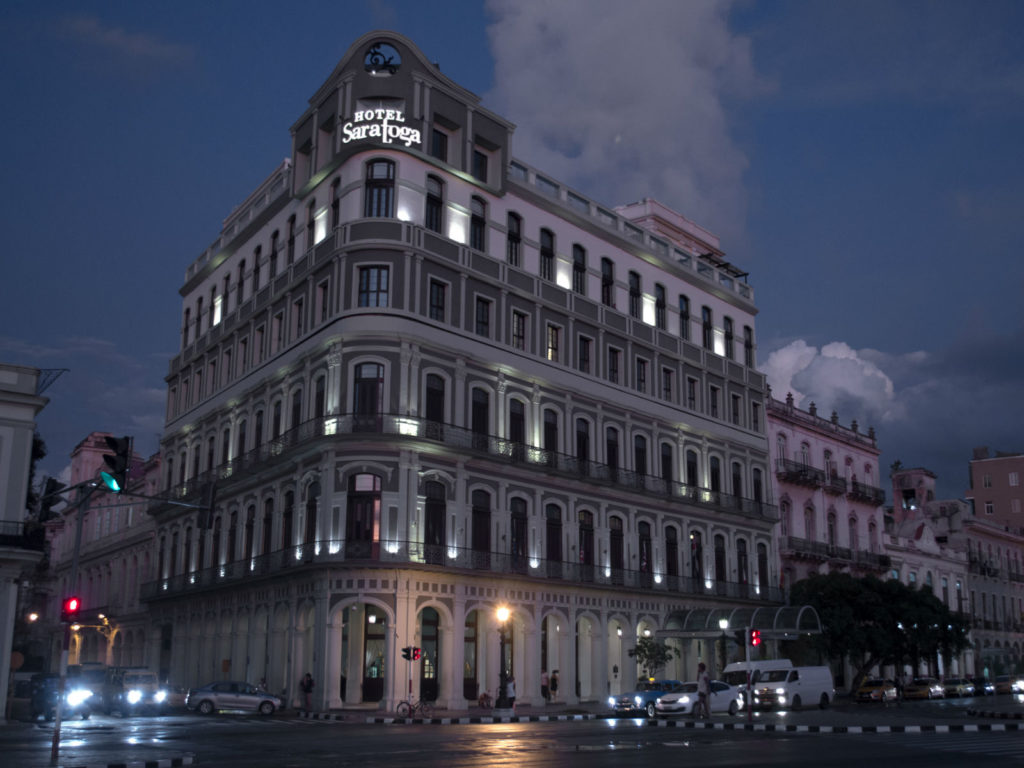
Above: 21 March 2013. Saratoga Hotel, where we spent the evening of 20 March 2013, the final night of our Cuba motorcycle tour.

Above: Room of Mwah (sic), Saratoga Hotel, Havana Cuba. 21 March 2013.
This room was the best of the rooms I stayed during eight nights in Cuba... even so... it was a bit frayed. No duvet, which is, now, usually expected in international class hotels.
Yesterday's picto diary featured an image of the Art Deco Saratoga bar. The exterior of the hotel is neo classical. All in all, the hotel design is somewhat eclectic.
But all of our hotels... including the home where we stayed in Trinidad, were very clean with clean linens.
The hotel in Vinales, third day out, had only a trickle of water, none of it hot.
I've traveled in more Spartan situations.
All in all the hotel situation for our tour in Cuba wasn't bad.

Above: Partagas Tobacco factory, across square from Saratoga, Hotel. 21 March 2013.
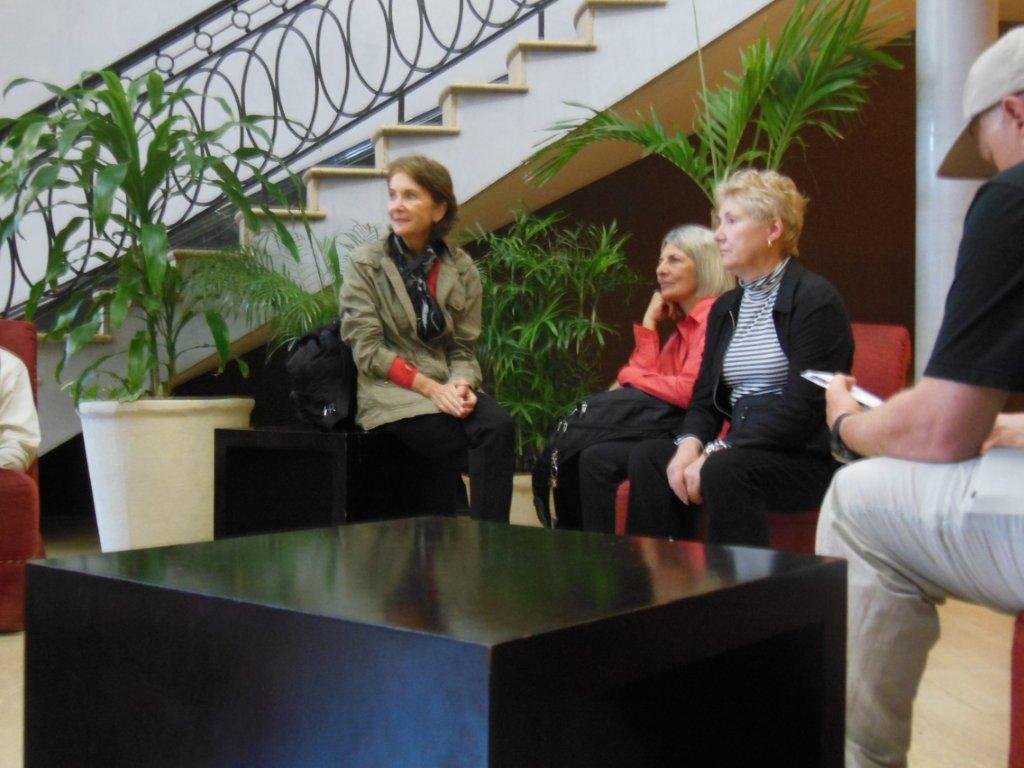
Above: Waiting at Saratoga lobby for bus to take us to the airport. 21 March 2013.
Left to right, Claudia (Brazil), Bonnie Hunt, and Kim Novak.
Bonnie Hunt, via Chicago, lives on the Lost Coast of California with husband Crocker, where, together, they are vintners.
Kim Novak, also via Chicago, lives in Taos, NM with husband Taos. Kim recently retired from consulting work where her largest client was the city of Chicago.
Both Bonnie and Kim are inveterate motorcycle adventurers riding pillion behind their husbands. I have been on numerous international motorcycle trips with them. Also, we have (along with TIMDT and their husbands, shared ski vacations with them in Park City and Telluride.
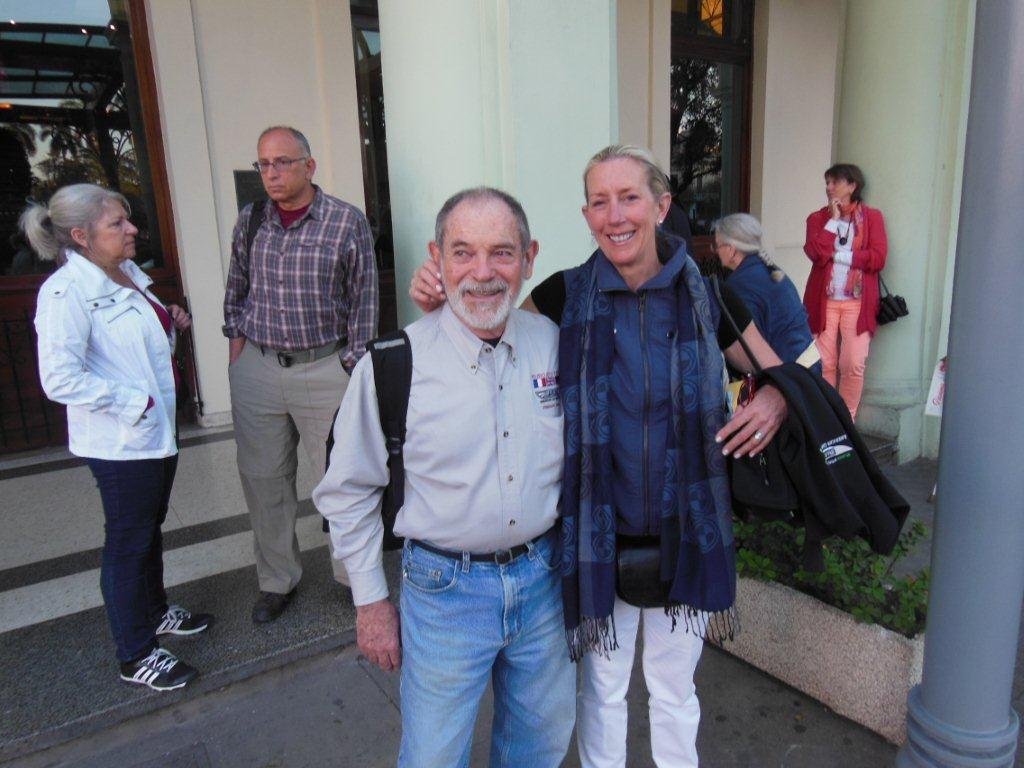
Above: Isetta and Teeny Tiny. 21 March 2013.
Teeny Tiny, was a school teacher in Chicago before marrying Isetta thirteen years ago. Under Isetta's tutelage, she took up motorcycling and now rides, with her husband, in numerous places around the world. I've had the privilege of having joined her and Isetta on many of those trips.
She has her own consulting firm, Teeny Tiny Productions, out of which she organizes auto shows for vintage small cars and provides business consulting assistance for small businesses.
Teeny Tiny currently heads a membership drive for the LeMay Museum - America's Car Museum, in Tacoma, WA.
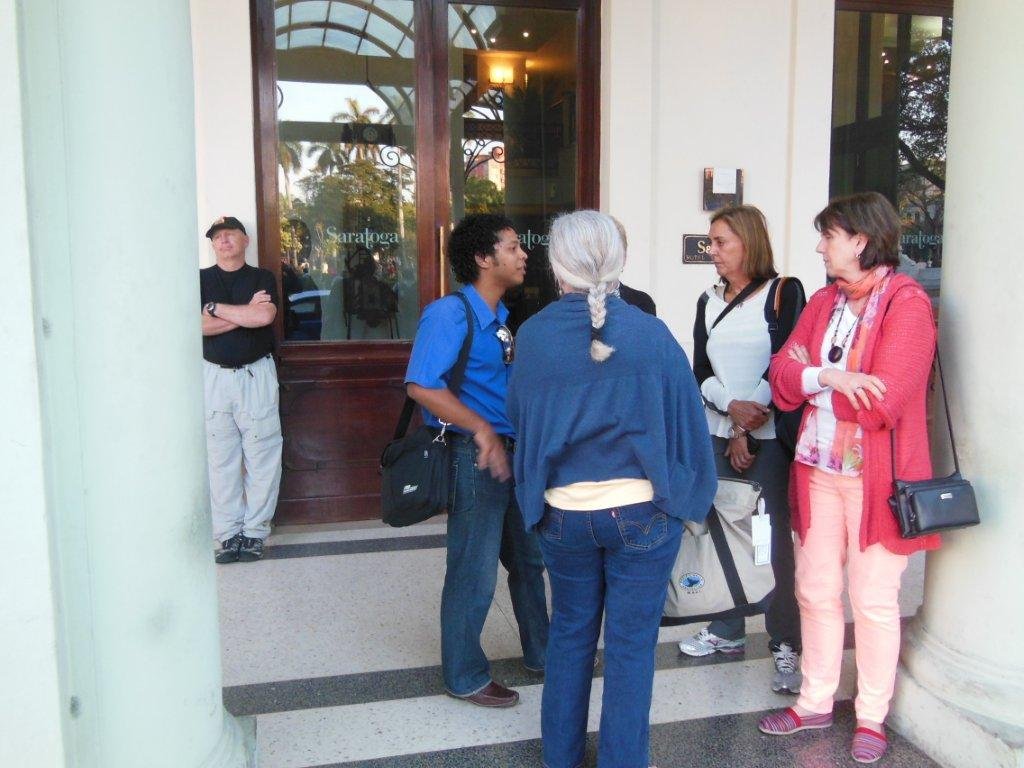
Above: Adrian talks to tour members, Sandra, Kathy and Susan prior to departure to the airport. 21 March 2013.
Adrian was assigned to our group by the Cuban tourist office which provided busses (when we weren't riding) and other logistical assistance for our tour.
Adrian was a pleasant and cheerful young man probably not quite through with his training on how to deal with foreign tourists.
The Cuban tourist office is a subsidiary of the Cuban military and, likely, Adrian had done his stint in the army to be followed by the job he has now in the tourist bureau.
While at Luis house, yesterday, after viewing Luis' collection of Harley Davidson motorcycles, I walked, alone, out of the garage to the street ahead of the other tour members who were still lingering by the bikes. I wanted to get some images of the beautiful street including the bougainvillea.
Adrian saw me, walked up to me, and said, "Taylor! Bored?"
I laugh as I write this. He was a nice kid. I'm sure he will make a good representative of Cuba's tourist effort some day.... after a bit more training.
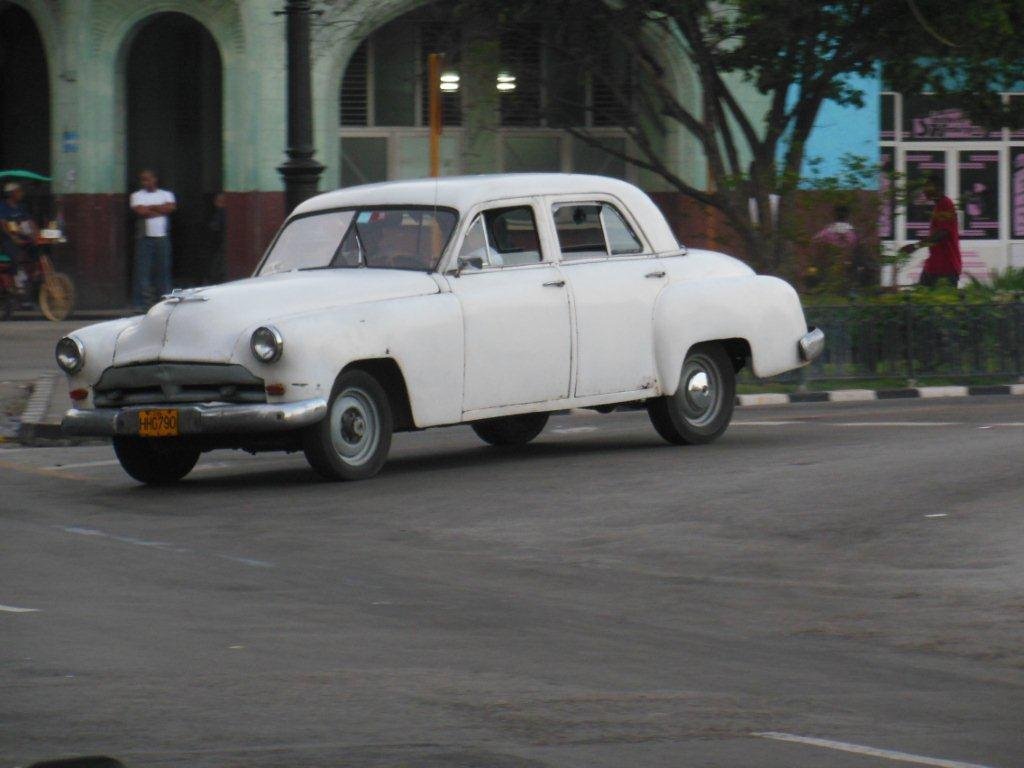
Above: 51 or 52 Dodge or Plymouth. Havana, Cuba. 21 March 2013.
When our family returned to Provo, UT from NYC in 1952 after having lived there for two years, Dad bought a powder blue 52 Dodge. I was 8 years old in 1952. I remember the car vividly. We took a road trip in the car to Pacific Grove, CA to stay in a sea side cottage owned by friends of my parents. The car was truly "the cat's pajamas." And, here it is, operating on the streets of Havana.
Havana. The past brought forward? Time travel to the past?
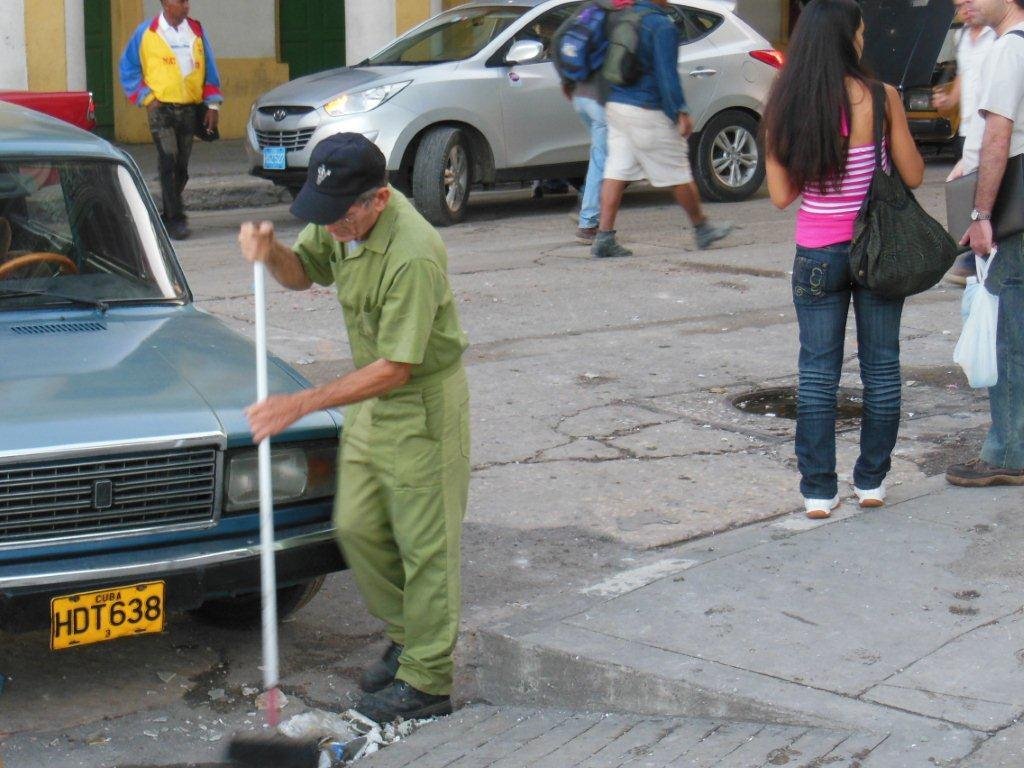
Above: Street sweeper outside Saratoga Hotel. 21 March 2013.
In conversations with tour companions it was frequently mentioned how clean and litter free Cuba was. One tour member suggested this might be due to the extensive education system in Cuba, which delivers a near 100% literacy rate in the country.
An old Russian Lada auto is at left. Upper center of the image is a late model auto with a diplomatic tag.
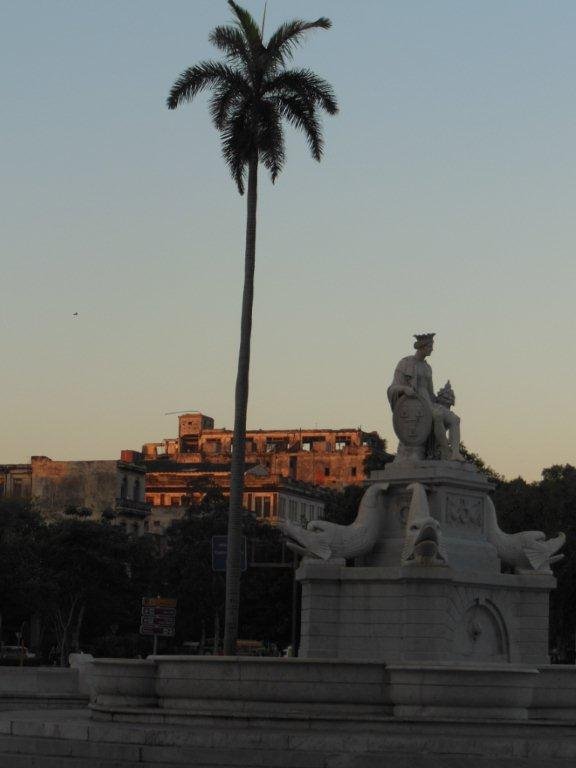
Above: Sunrise, Fraternity Park (as seen from in front of Saratoga Hotel). 21 March 2013.
The image of a decaying structure capturing the rising sun, the palm tree, and the neoclassical fountain and statue, seems to be a good metaphor for Cuba today: a beautiful, tropical nation, with only its past to celebrate.
Reflections:
Alone today, only Cuba and North Korea are hold-outs supporting Communist, totalitarian government.
The standard of living of the average Cuban citizen has been subsistence level for two generations... only held up by foreign payments from the USSR, through 1992, and since, by Venezuela and China.
Cuban sugar exports have gone from 40% of total exports at the time of the revolution to 10% of total exports today.
Cubans have restricted access to the outside world.
A decaying infrastructure and a low standard of living for the last two generations of Cubans is a sad legacy of communist government.
The Cuban people we met appeared to be happy to see us US visitors. Yet, it must be remembered that thousands of Cuban dissidents are currently jailed (and have been executed) and that since the revolution over 200,000 Cubans risked death to cross on overcrowded rickety craft, rafts or inner tubes to cross the Florida Straits in an escape to freedom.
Contrast the economic failure seen in Cuba today with the success of the Cuban migrants in South Florida. A friend, a Miami philanthropist, Shepard Broad once told me that Miami should honor Fidel Castro with a monument in Miami's Bay Front Park. Castro's discarded Cubans, so Shepard noted, have been responsible for creating an economic boom in south Florida.
Cubans thrive, prosper, and create economic growth in Miami.
Cubans in Cuba destroy wealth, export military adventurism, and radically constrain individual Cubans' freedom, in Cuba over the last two generations.
Same people. Two different outcomes.
We saw evidence of liberalization in today's Cuba. 20% of the country's production is now in private hands, up from 10% in 2000. There is an embryonic entrepreneur class developing.
Foreign travel is now allowed.
Notwithstanding some attempts to liberalize in Cuba, US Cuba relations remain stalled due to Cuba's confiscation of US assets ($10 billion in current dollars) at the time of the revolution.... and due to Cuba's denial of freedom to its people.
Relations between the two nations should not be normalized (ie the embargo lifted) until the economic debt from Cuba to America is somehow "regularized."
I suspect that this won't occur until after the Castros are gone - Raul says he'll stay in office until 2017. Cuba's new VP, Miguel Diaz-Canel, putative successor to the Castros, will likely trigger a debt resolution commission after the Castros have left the scene.
In debt resolution negotiations, the two countries, the US and Cuba, will likely agree to a haircut on the debt in return for favored US economic involvement and assistance in Cuba. Cuba will also have to accelerate facilitation of private ownership and individual freedom as well to justify any debt haircut.
Cuba's efforts to liberalize are welcome, but, until the debt is resolved, the embargo cannot be lifted. Robbery cannot be unilaterally forgiven... and the stripping of freedom from two generations of Cubans cannot be white washed.
It is written.
Addendum:
Looks like an interesting trip, Steve. The Salt Lake City t-shirt was some kind of sign.
: )
HELOC,
Plantation, FL
Steve, We were there a few years ago and will be interested in exchanging views about the geopolitical/ cultural conclusions you reached as the result of your very interesting trip.
The Archbishop,
Naples, FL
See "reflections" above.
Thanks Steve for all of the interesting things I've learn from your travel logs. It must be obvious to all that you put a lot of work into these logs; hopefully you know how much we appreciate them.
Nathans,
Orlando, FL
Thanks for sharing your beautiful trip. Loved it.
KAT,
Dallas, TX